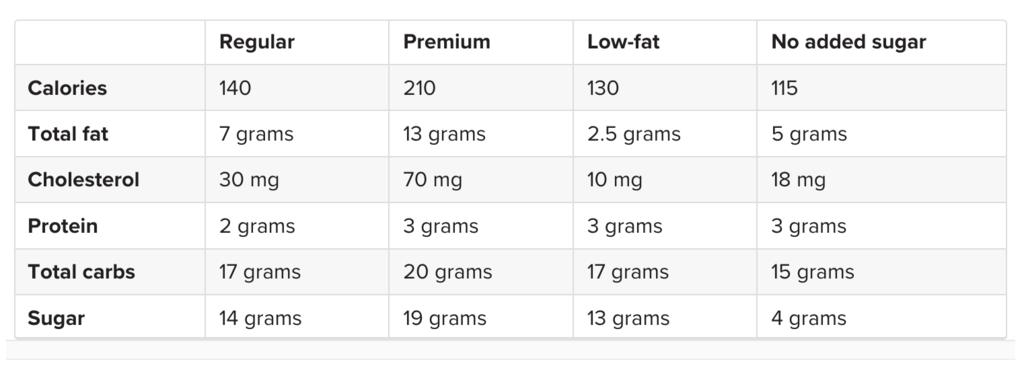To help you out, we’ve put together a list of vegetables that are keto-friendly and those you should avoid. Let’s get to it, shall we?
What is the keto diet?
Here’s a quick reminder of what the keto diet is: it’s a popular weight-loss strategy that requires dieters to cut their carbohydrate or carb intake to no more than 50 grams per day. You do this so you get into a state of ketosis, a state where you will start burning fat for fuel. As a result of going low carb, you lose weight!
However, that’s not the only thing keto can do for you. Some research shows that keto can improve your heart health, lower your bad cholesterol level, and reduce your risk of developing heart disease. Going on keto diets is also a great way to help treat age-related neurological decline such as Alzheimer’s disease.
There are even ongoing studies that say keto can prevent and treat cancer. It is hypothesized that cancer cells feed off carbs and blood sugar to grow and multiply, and by lowering your carb intake, you’re starving cancer cells’ fuel, which may cause them to decrease in size and die.
Of course, while a low-carb diet seems to carry plenty of health benefits, please don’t take any of the information we put here as strict medical advice. For additional information, it is best to consult with a registered dietician or a doctor.
On to the main topic. The big question: can you eat vegetables on the keto diet?
The answer is yes. However, in our quest for healthy eating, we might automatically assume that since vegetables are green, natural, and aren’t sweet, all are okay to eat on the keto diet. But that’s not the case—and you’ll find out why in the next section.
Vegetables To Limit On The Keto Diet
Starting a keto diet means watching your carbs, and that includes the veggies you eat. Not all vegetables are low in carbs, so it’s important to know which ones to limit.
What vegetables are bad for the keto diet (or at least, not recommended)? Read on.
Carrots
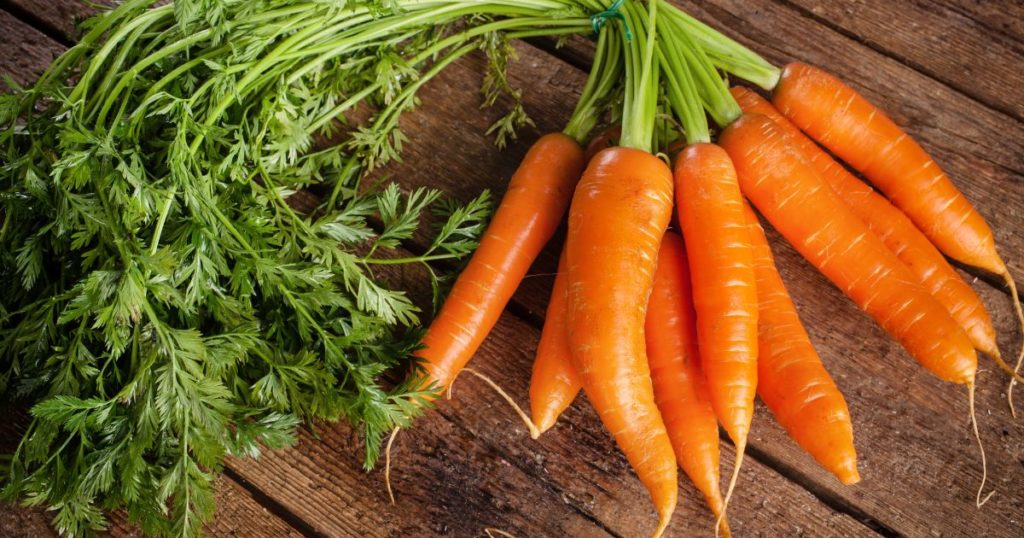
Carrot cakes (like the one in Chef Joey Prats’ class) are definitely not allowed, unless it’s a keto carrot cake like the one in Ms. Chiqui Ortiz-Dingcong’s class. But what about carrots themselves?
Well, bad news: carrots have more carbs than some other vegetables, with about 9 grams of carbs in each serving. If you’re on a keto diet and trying to keep your daily carbs under 50 grams, you’ll need to be careful about how many carrots you eat. It’s best to eat them in small amounts to stay within your carb limit.
Sweet Potato
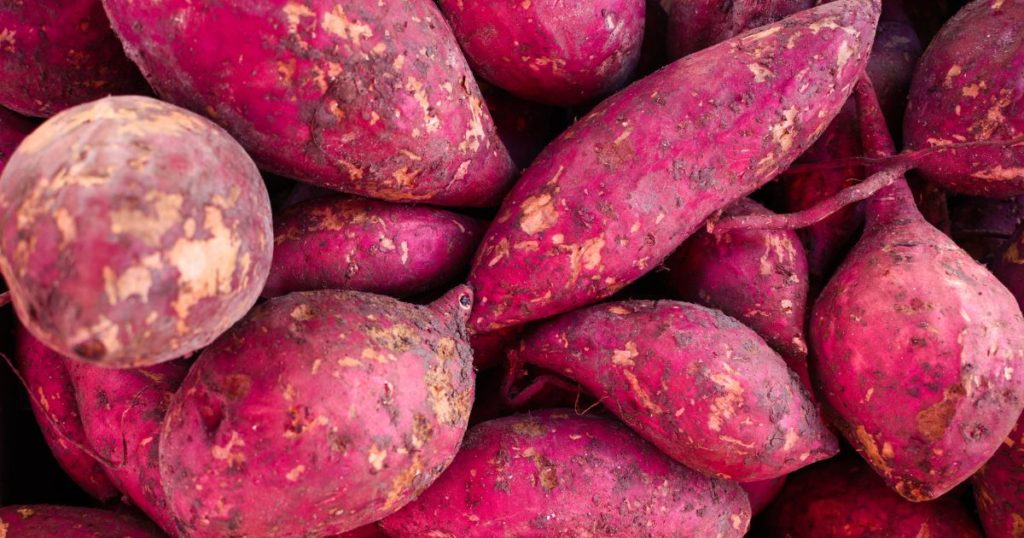
Sweet potatoes, including those turned into your favorite side dish like fries, are naturally high in carbohydrates. This (as well as other starchy vegetables) can pose a challenge for those on a keto diet, aiming for very low daily carb intake. Because of their carb content, sweet potatoes can make it harder to stay within the limits needed to maintain ketosis.
Legumes
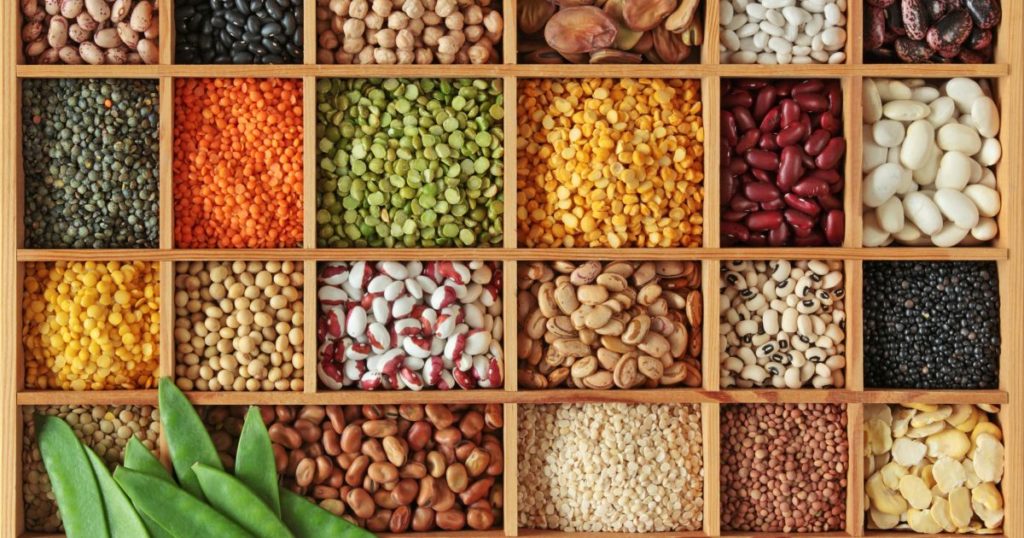
Legumes, including soybeans, peanuts, and lentils, are a popular protein source for vegans. However, these vegetables contain high carb content. This makes it difficult to stay within the low-carb limits required to maintain ketosis and achieve the full benefits of a keto diet.
Peas
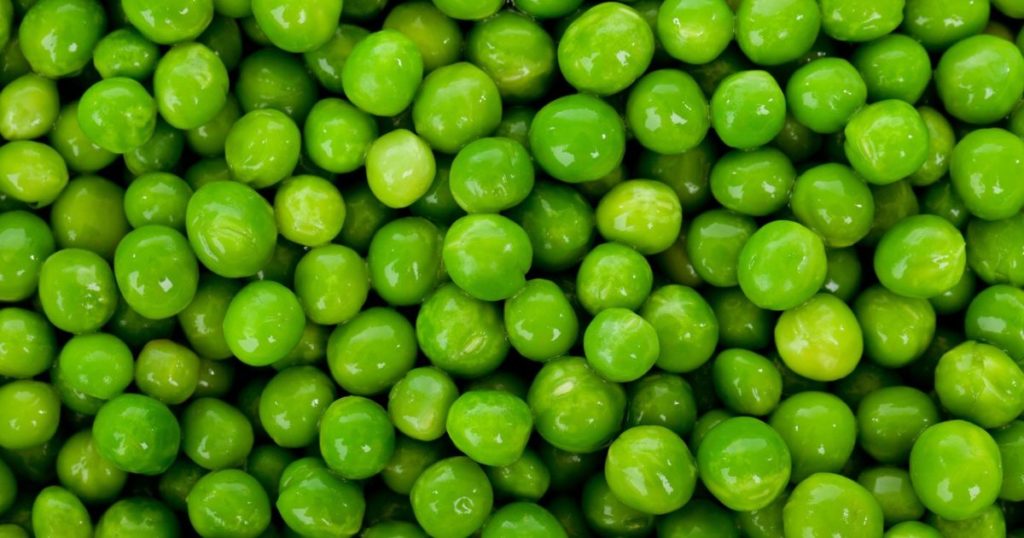
Don’t be misled by their small size—peas are high in starch, which means they’re also high in carbohydrates. Eating peas in large amounts can disrupt your meal planning and make it harder to stay within your daily carb limit. In short, it’s best to limit your intake of peas.
Onion
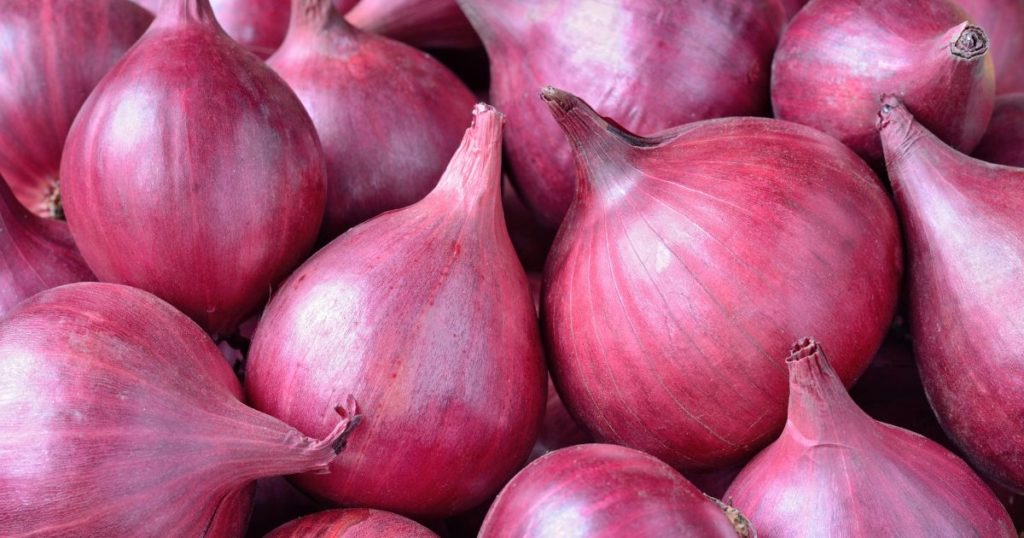
Don’t get us wrong: we at The Bailiwick Academy love onions. We even have a course all about onions! However, if you’re following a ketogenic diet, it’s important to use onions sparingly. Despite their delicious flavor and many uses, onions contain carbs that can add up quickly, making it necessary to moderate their use to stay within keto’s strict carb count.
Corn
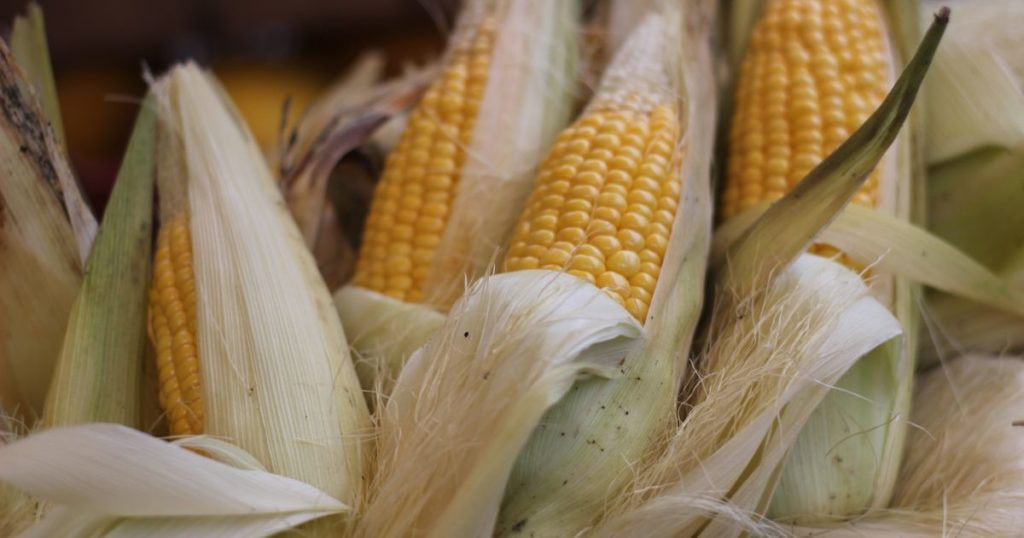
Corn is another food that might be tempting due to its sweet taste, but it’s not suitable for a ketogenic diet. It’s another vegetable high in carbohydrates, which can interfere with your efforts to maintain ketosis and achieve your weight and health goals. If you’re serious about sticking to keto, it’s best to limit or completely avoid corn.
Yam
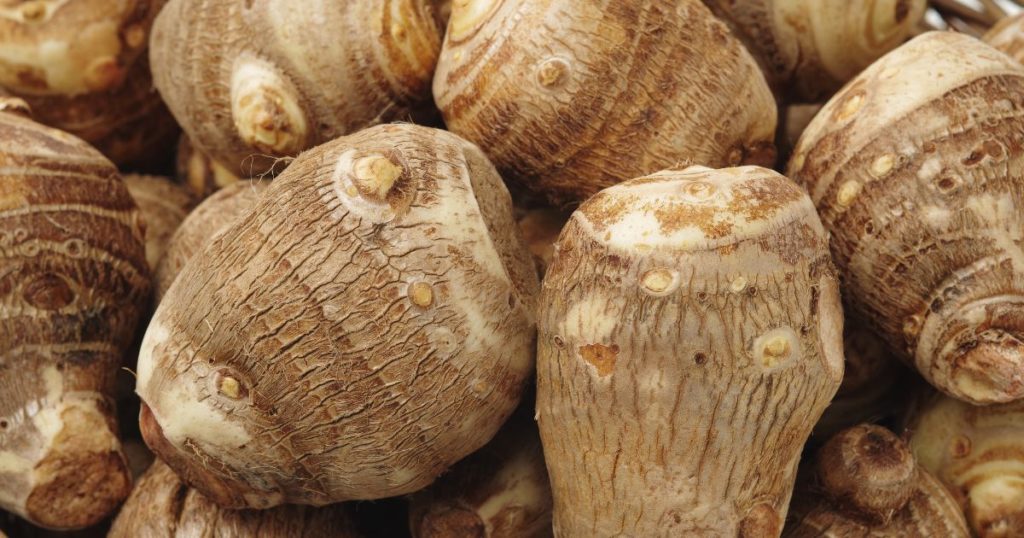
Yam is a root vegetable that packs a hefty carb count, ranging from 22 to 42 grams per serving. This is even higher than what you find in sweet potatoes. In other words, you’re not going to see yam in any type of keto meal plan.
Best Vegetables For The Keto Diet
This section is going to make you happy because it will show you which veggies are best for staying low in carbs but still getting plenty of nutrients.
Spinach
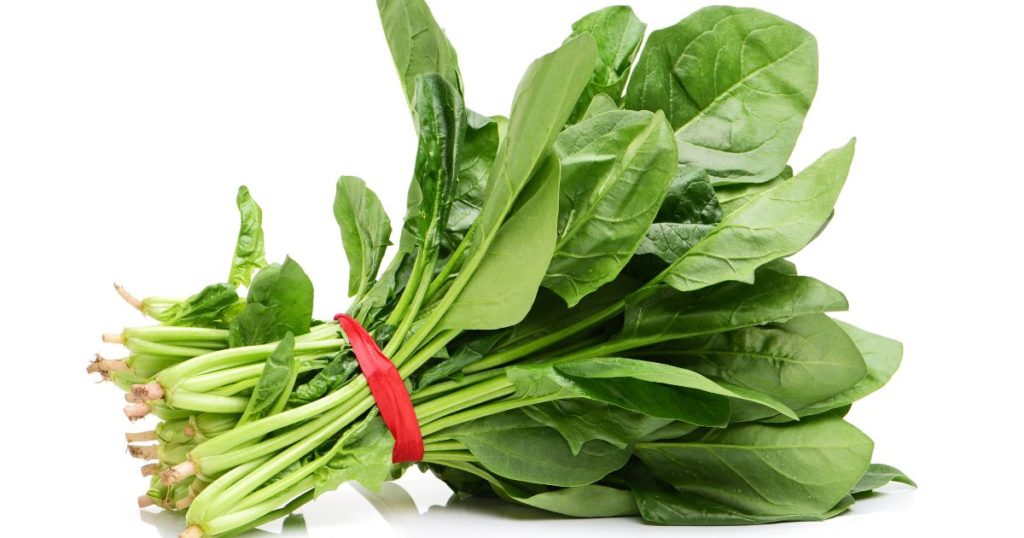
Spinach is a powerhouse of nutrients, rich in vitamins A and C, potassium, folic acid, iron, and calcium. Incorporating spinach into your diet can offer health benefits such as cancer prevention and reduced blood pressure. It’s not only beneficial for your overall well-being but also fits perfectly into a keto diet due to its low-carb content.
Bok Choy
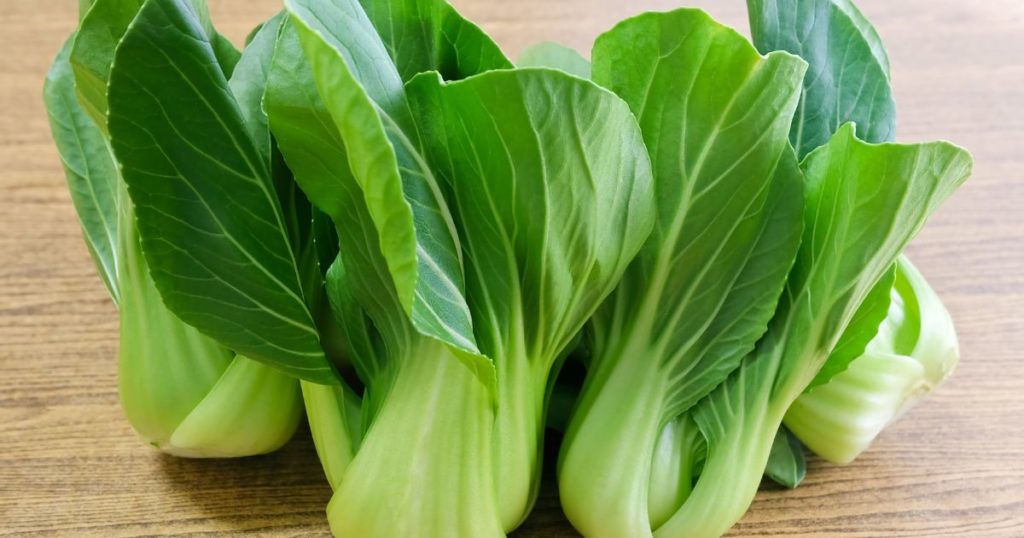
Bok choy is loaded with compounds that can help fight cancer, including vitamins C and E, beta-carotene, folate, and selenium. These nutrients not only contribute to its powerful antioxidant properties but also make bok choy a valuable addition to a keto diet, offering health benefits without adding many carbs.
Kale
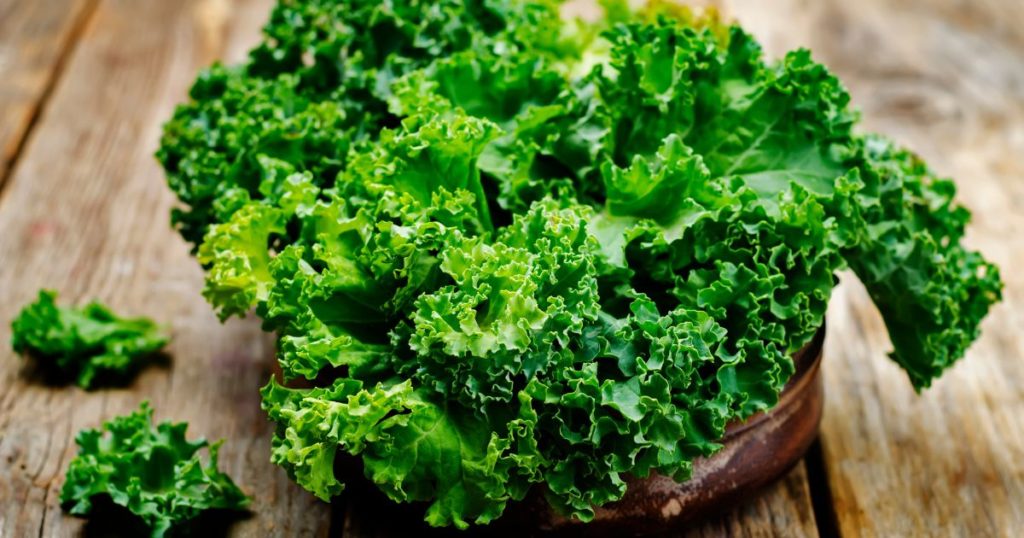
Kale is a nutrient-dense leafy green that’s low in carbs and high in beneficial nutrients. It’s packed with fiber, vitamins, minerals, and antioxidants that help prevent or slow cell damage. Regularly eating kale can lower your risk of type 2 diabetes, protect against heart disease, and promote healthier bones, skin, and hair. It’s an excellent vegetable for anyone on a keto diet, contributing to overall health without compromising carb limits.
Broccoli
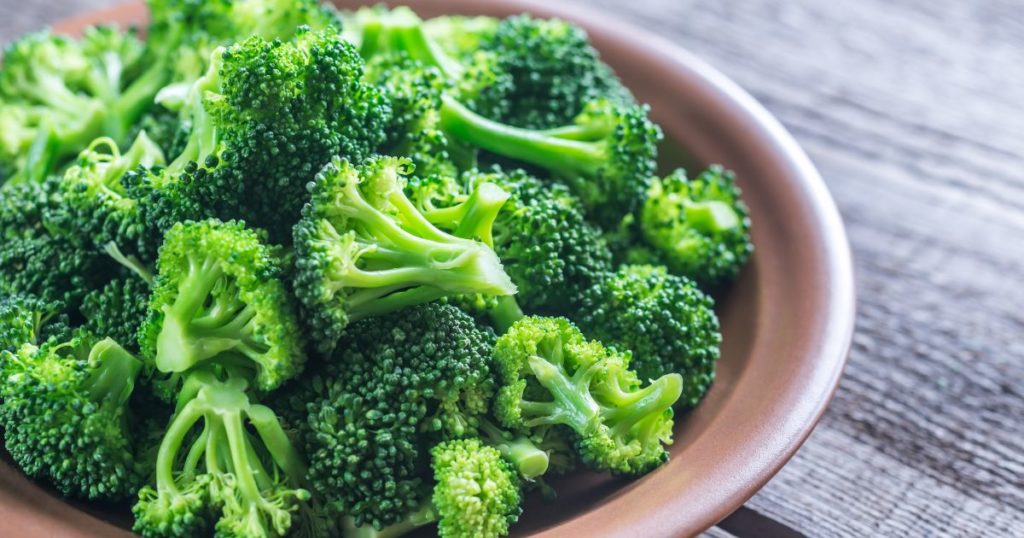
Broccoli is a versatile vegetable that can be enjoyed in various forms—raw, blanched, steamed, or roasted. It fits well in salads, side dishes, soups, pastas, and even as a rice substitute. Beyond its plenty of uses, broccoli is also a rich source of calcium, which is crucial for maintaining strong bones and preventing osteoporosis. This makes it a valuable addition to the keto diet, offering versatility and essential nutrients.
Cauliflower
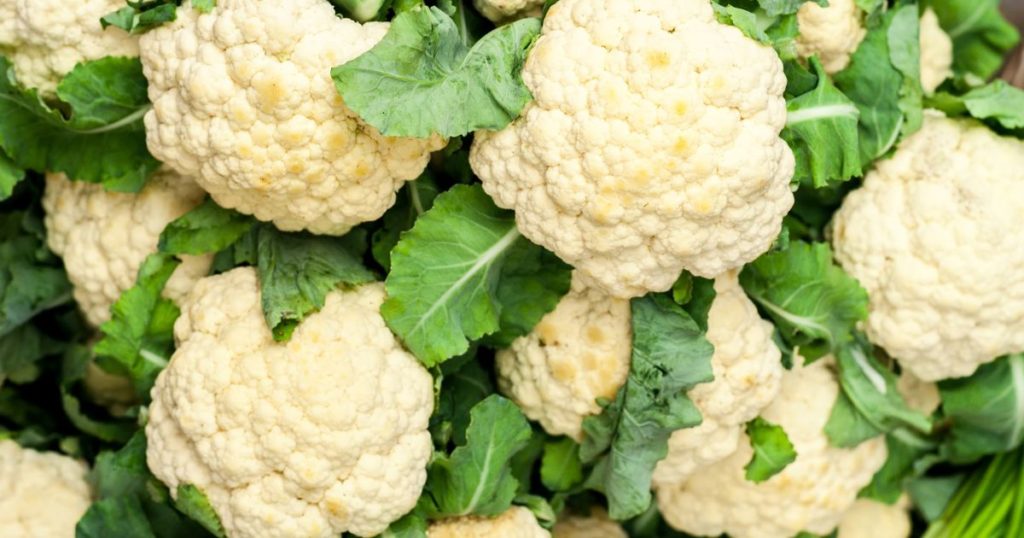
Cauliflower is a superfood that offers significant health benefits, including cancer prevention and improvements to gut and heart health. Its versatility is similar to broccoli, allowing it to be used as a rice substitute (yes, cauliflower rice is a thing!) or incorporated into various dishes. This makes cauliflower another excellent choice for those on a keto diet.
Asparagus
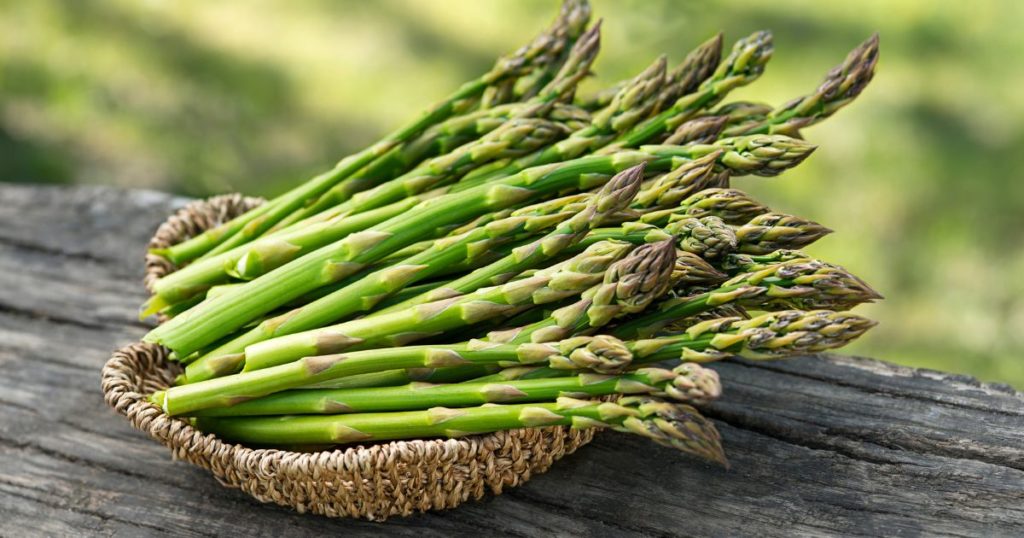
Asparagus might be known for its peculiar effect on the smell of urine, but its benefits far outweigh this minor quirk. It’s excellent for weight loss, helps prevent urinary tract infections, and can even boost your mood. And like all the others on this list, asparagus is a great choice for those on a keto diet.
Zucchini
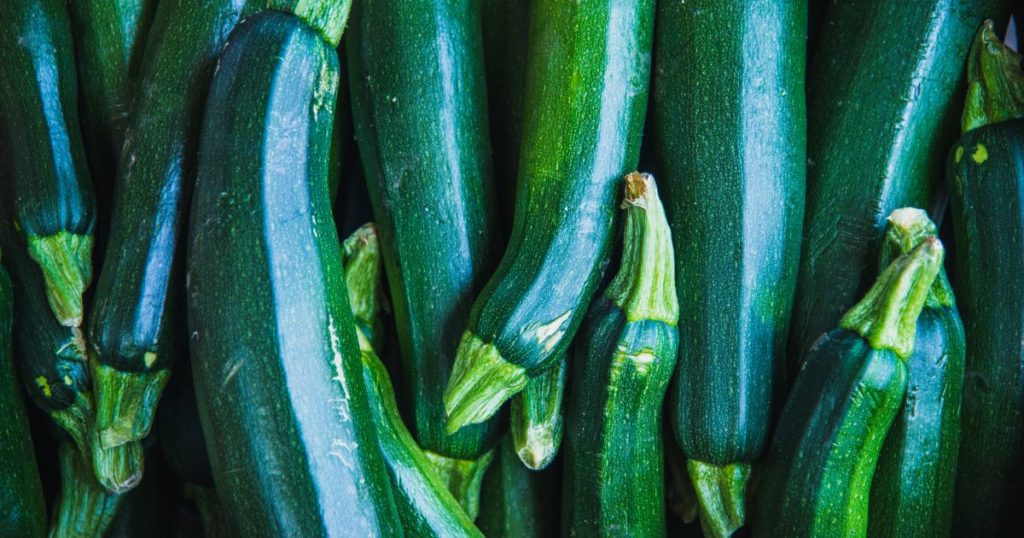
How To Ensure The Vegetables You Eat Are Keto-Diet Approved
Now you know what vegetables to eat and avoid while you’re on a keto diet. The next problem is this: what about vegetables that aren’t on this list? How can you find out which ones are, and which ones aren’t?
For instance, what if you’re eating outside? How can you make sure that what you’re eating is keto?
Well, if you really want to stick to a keto diet, it’s best that you be the one to prepare your food.
And if you want to add veggies to the usual keto food like meats, here’s a better way of preparing them: through the Keto Salad and Wraps class by Ms. Chiqui Ortiz-Dingcong!
If you’re health-conscious or eager to dive into the culinary world as an entrepreneur, this course is designed to introduce you to a range of mouthwatering, healthy dishes. Enroll now and master the art of preparing:
- Keto Tortilla
- Keto Mediterranean Salad with Chicken Souvlaki and Wrap
- Keto Mexican Salad with Beef Strips and Wrap
- Keto South Asian Prawn Salad and Wrap
And don’t worry; like all the courses at The Bailiwick Academy, this course is structured to be straightforward and accessible, making it ideal even for beginners. You’ll not only learn the basics of creating Keto Salads and Wraps but also acquire advanced culinary skills that will elevate your cooking.
Plus, this course will ensure that eating vegetables will never, ever be boring!
So what are you waiting for? Sign up now at The Bailiwick Academy! See you inside!
]]>Well, it’s a type of cuisine that’s not only delicious but also good for your health. Here in the Philippines, we often think of yummy food as being oily and greasy, but Mediterranean food is different—it’s healthier.
Curious? Keep on reading as we show you how a Mediterranean diet can change the way you think about tasty foods. Whether you’re looking to eat healthier, want to cook nutritious meals for your family, or just discover more delicious food, exploring Mediterranean food is exciting and fun!
Let’s get to it, shall we?
So… what is Mediterranean-style food, exactly?
You might be Googling right now, going, “What classifies as Mediterranean food?” Well, Mediterranean cuisine or cuisines are quite unique compared to well-known types like American, Japanese, or Chinese. It’s not tied to a specific ethnic group but is a collection of culinary practices from people around the Mediterranean Sea, including countries like Spain, France, Italy, Greece, Turkey, as well as regions in the Middle East and North Africa.
What sets Mediterranean food apart is its use of fresh ingredients and unique flavors. The diet mainly focuses on plant-based foods such as fresh vegetables, fruits, whole grains, legumes, and nuts. Olive oil is essential, serving as the main source of fat.
Additionally, fish and seafood play a big role, while red meat and dairy are less common but are still included. Herbs and spices are key for adding flavor, and there’s often a moderate consumption of wine, either red wines or white ones.
Origins of Mediterranean cuisine
The origins of Mediterranean cuisine are deeply rooted in the history of the various cultures that have lived around the Mediterranean Sea. These include ancient civilizations like the Egyptians, the above-mentioned Greeks, and Romans, who left their mark on the region’s food culture. The Mediterranean’s role as a major trading hub was crucial, as it connected Asia, Europe, and Africa, allowing for the exchange of spices and other ingredients that enriched local diets.
Significant influences also came from the Moors in Spain, who introduced ingredients such as rice, sugar, and almonds (and, totally unrelated but fun fact, also influenced arroz con pollo). Furthermore, the discovery of the Americas brought about new Mediterranean foods, including tomatoes, potatoes, and peppers, which added vibrant flavors and colors to the cuisine.
As these different cultures interacted and traded, they blended their culinary practices, creating a diverse and rich culinary tradition that spans the Mediterranean region, reflecting its historical connections and the natural bounty of its climate.
Common Elements of Mediterranean Cuisine
Now, you might be thinking that all these Mediterranean countries are different from one another, and it’s hard to memorize which country cooks what. So, to clear things up, let’s talk about the key ingredients that run through Mediterranean cuisine. Here’s what they generally share, no matter where they are in the Mediterranean region:
- Fresh, Whole Foods: Vibrant plant-based ingredients like vegetables, fruits, whole grains, nuts, and seeds dominate the menu.
- Olive Oil: This heart-healthy oil is a staple. Dishes will either be cooked in olive oil or have an olive oil drizzle.
- Herbs and Spices: The use of fresh and dried herbs like mint, basil, and thyme, along with spices such as cumin and saffron, adds depth and flavor to every meal.
- Nuts: Snack on them, toss them into salads or use them in desserts. Nuts like almonds and pistachios are everywhere.
- Whole Grains: Staples like couscous, quinoa, and bulgur wheat are common and provide a filling base for many dishes.
- Tomatoes: A key ingredient in sauces, stews, and fresh salads, tomatoes are a fundamental part of Mediterranean recipes.
- Legumes: Chickpeas, lentils, and various types of beans are crucial for adding texture and protein to meals.
- Meat and Seafood: Meats are usually grilled and seafood is abundant, reflecting the coastal lifestyle of many Mediterranean regions.
- Desserts: Sweet treats often incorporate fruits, honey, and nuts, sticking to natural sources of sweetness.
Why is Mediterranean food popular?
A simple reason why Mediterranean food is so popular is that the foods to eat here masterfully combine rich flavors, varied textures, and fresh ingredients in a way that’s deeply satisfying. It’s also easy to prepare: just toss the ingredients together, add a splash of olive oil, sprinkle some herbs and spices, and your meal is ready. It’s perfect for busy people looking for quick yet nutritious meals.
Mediterranean cuisine isn’t just tasty—it’s also good for your health. Benefits of the Mediterranean diet include lower and healthy blood sugar levels, reduced risk of heart or cardiovascular disease and Alzheimer’s, better weight loss, and improved cognitive function. In other words, the Mediterranean diet is delicious AND nutritious!
Examples of Mediterranean-style Food
Curious about what kinds of foods make up a Mediterranean diet? Check these out:
Baba Ganoush
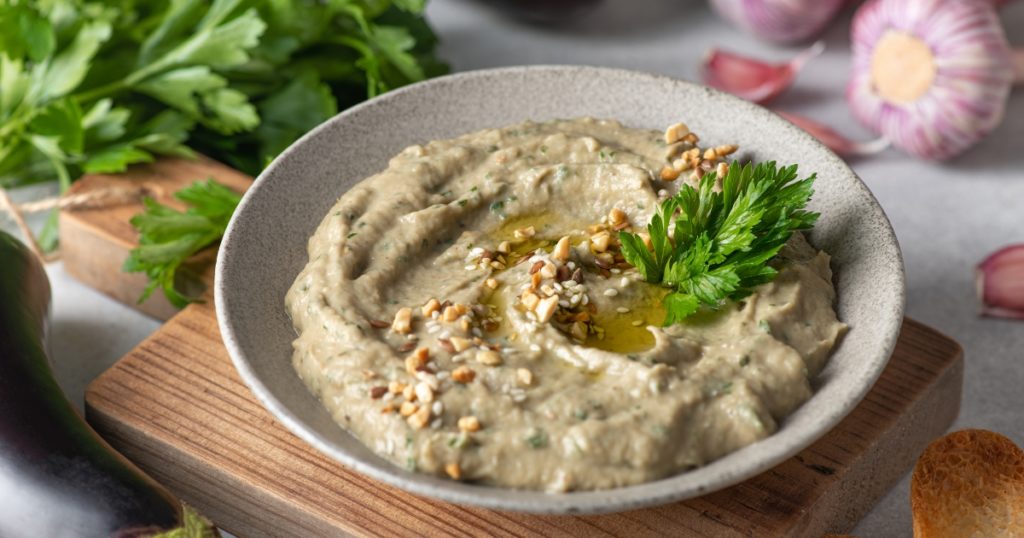
Baba Ganoush is a creamy, smoky eggplant dip that’s a favorite in Mediterranean and Middle Eastern cuisine. It’s made by blending roasted eggplant with tahini, garlic, lemon juice, and spices. This appetizer is loved for its simple yet rich flavors and health benefits—it’s low in carbs, vegetarian, and gluten-free.
Enjoy it with veggies or pita chips, or spread it on sandwiches and wraps for a delicious taste of Mediterranean goodness.
Fun trivia: Baba Ganoush means “spoiled dad”. Who wouldn’t feel spoiled after eating this creamy, savory, and addicting dish?
Lentil Soup
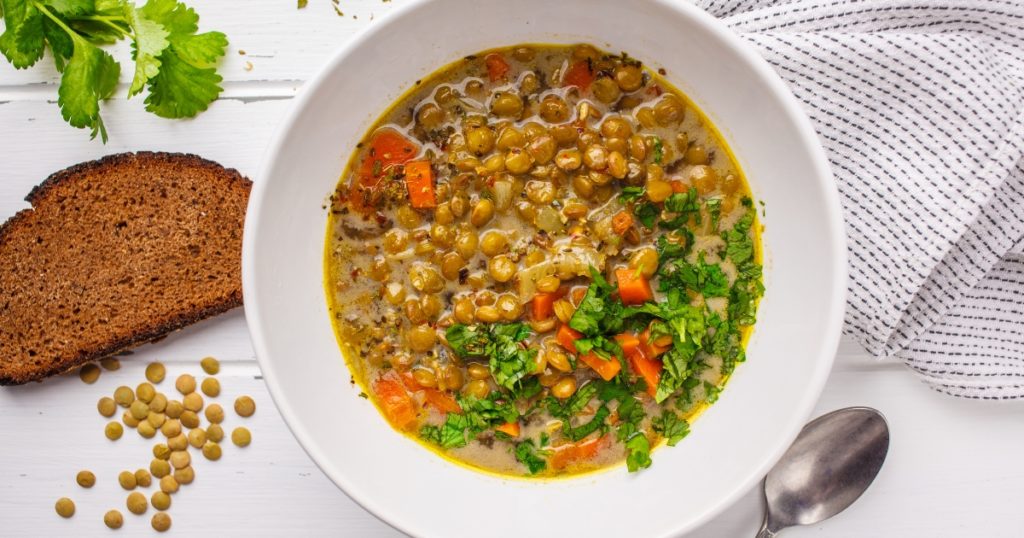
Lentil soup is a hearty and nutritious choice popular in vegetarian diets. Made from lentils, which come in colors like green, brown, and red, this soup is rich in protein and fiber. The soup includes vegetables and spices like onions, carrots, garlic, and cumin, offering a comforting and flavorful meal. It’s perfect on its own or served with a slice of crusty bread.
Cucumber and Tomato Salad
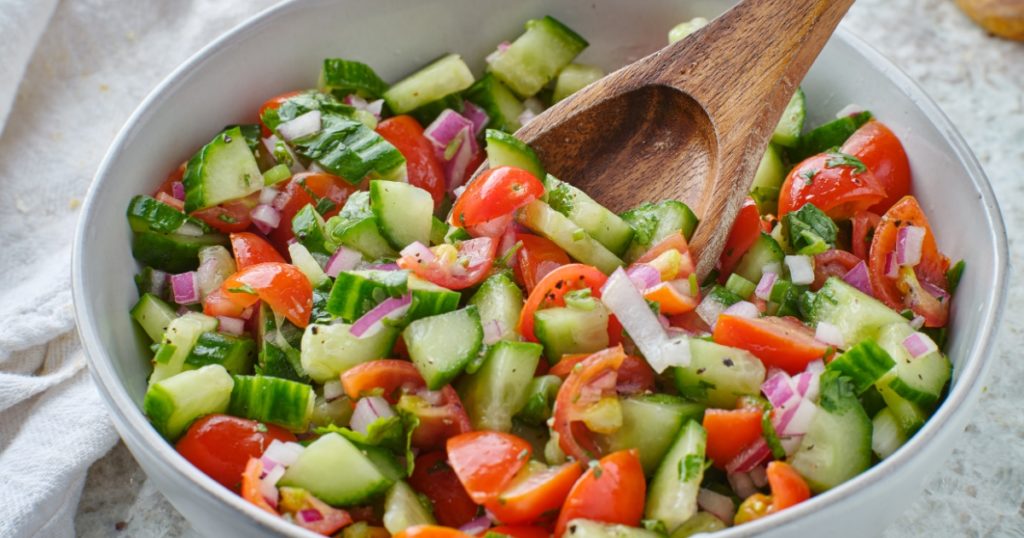
Cucumber and Tomato Salad is a staple in Mediterranean cuisine, known for its simplicity and freshness. It’s mainly made with cucumbers and tomatoes, often tossed with onions, parsley, and sometimes red peppers. For an extra touch, you can add some feta cheese.
Dress up the salad with a drizzle of olive oil, a splash of vinegar, and a squeeze of lemon juice. This light and healthy salad is perfect as a side or as a complement to other dishes.
Baklava
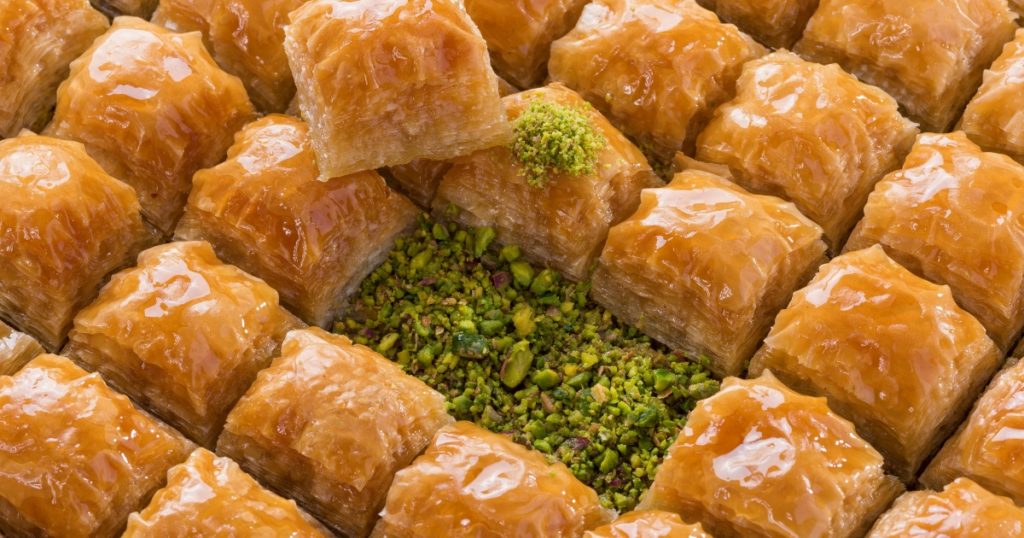
Baklava is a beloved dessert from the Mediterranean and Middle East, made with layers of thin filo pastry, filled with chopped nuts, and sweetened with syrup or honey. It’s popular in countries like Greece, Turkey, and Lebanon. The dessert varies regionally; some versions use walnuts, almonds, or pistachios, and may include spices like cinnamon or flavorings like rose water.
To make baklava, layers of phyllo dough are brushed with butter, filled with nuts, and baked until golden. After baking, a sweet syrup is poured over to soak into the layers. Baklava gets even tastier after a day, making it perfect to pair with black tea. This treat is not only delicious but also steeped in a rich history.
Here’s another fun fact: there’s so much debate about where Baklava came from. Greece and Turkey both claim it came from them, but one thing’s for sure: no one can contest that it’s one of the best desserts the Mediterranean cuisine produced.
Pita Bread
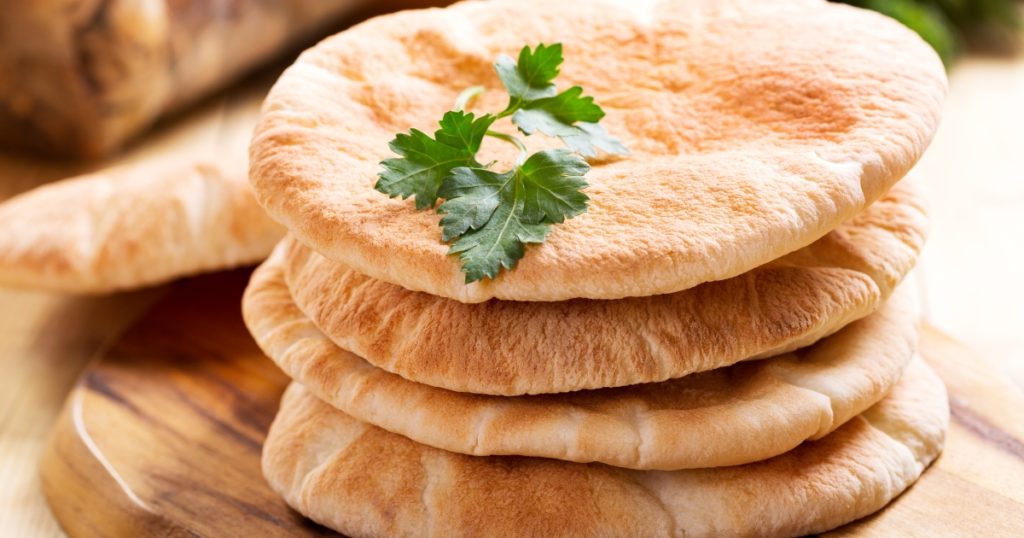
Your Mediterranean food experience will not be complete without Pita bread. This flatbread is made from a simple dough consisting of wheat flour, yeast, water, and salt. After mixing, kneading, and allowing it to rise, the dough is shaped into small balls, rolled out into thin circles, and baked at a high temperature. This process causes the bread to puff up, creating a pocket in the middle.
Pita is perfect for stuffing with fillings like falafel or vegetables and is commonly used for sandwiches and wraps. It also pairs wonderfully with dips such as hummus and baba ganoush. Whether used as a wrap or served plain as a side to various dishes, pita bread completes any Mediterranean meal.
Want to experience our class that involves pita bread? Check out Chef Max Nadin’s Pocket Bread class.
Shakshuka
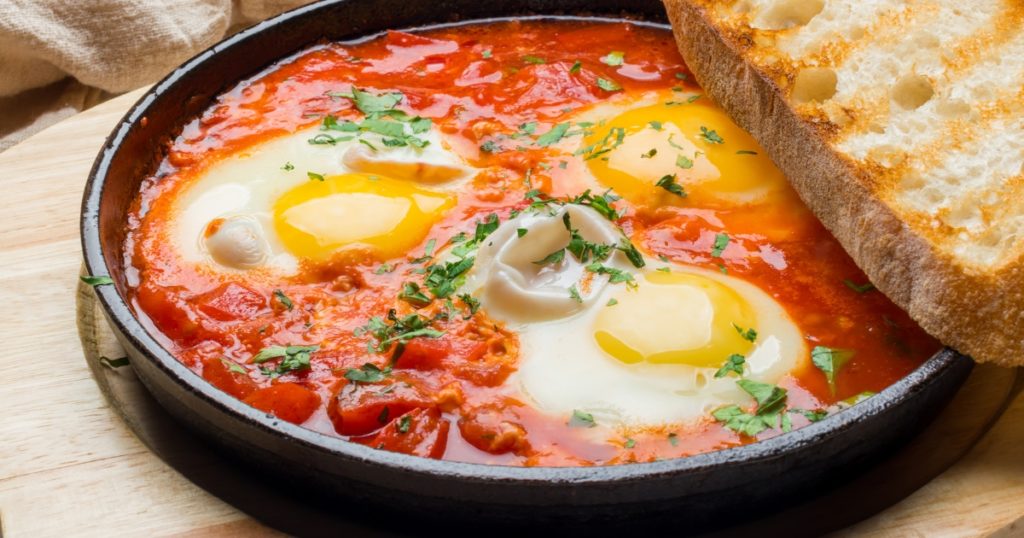
Shakshuka is a vibrant one-pot dish beloved in Mediterranean cuisine, known for its poached eggs simmered in a spicy tomato sauce with onions, bell peppers, and garlic. Originating from Tunisia, where it’s called “a mixture” or “shaken,” this dish packs a punch of flavor with its fresh herbs and a drizzle of extra virgin olive oil.
It’s a versatile meal that can be enjoyed for breakfast, brunch, lunch, or dinner and is often served with bread like pita or challah for dipping into the rich, flavorful sauce. Simple to make yet rich in taste, Shakshuka proves that nutritious and delicious can indeed coexist beautifully in a single dish. Whether you stick with the classic recipe or add your own twist with different spices or vegetables, it’s a satisfying meal that’s sure to impress.
Labneh
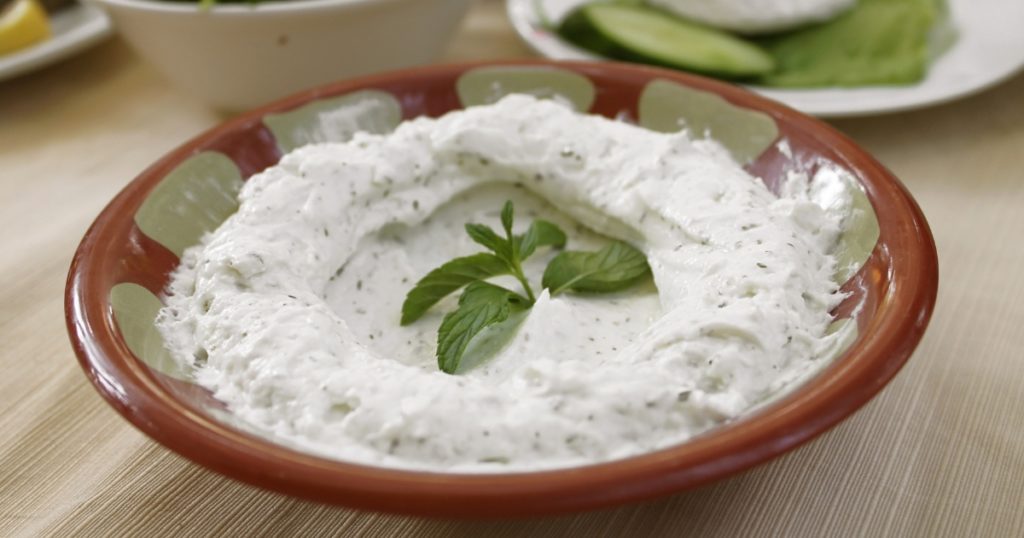
Labneh is a thick and creamy Middle Eastern yogurt dip, made simply by mixing yogurt with a little salt and straining out the whey. Often called labneh cheese due to its thick, spreadable texture, it has a tangy, rich flavor that pairs wonderfully with warm pita bread or pita chips, often drizzled with extra virgin olive oil.
You can also use labneh as a sandwich filler, or as a tasty topping on flatbreads like manaqeesh. It’s a common breakfast or snack item in Middle Eastern cuisine and can be customized with different levels of salt or marinated in oil and herbs for an extra flavor boost. Whether you call it labaneh, labne, or lebnah, it’s a versatile and delicious addition to any meal.
Want to make Mediterranean-style food at home?
Ready to try making Mediterranean-style food at home? It’s easier than you might think! That’s especially since here at The Bailiwick Academy, you can learn Mediterranean-style food recipes with Sir Rodney Martinez latest cooking class: Mediterranean Medley!
Enroll and you’ll no longer be wondering “What is a Mediterranean food menu made of,” because you’ll learn to make the following Mediterranean dishes:
- Baba Ganoush
- Labneh
- Shawarma Pita
- Hummus
- Shawarma Rice
- Falafel with Tzatziki
Just like all the the classes at The Bailiwick Academy, it’s an easy-to-follow class, perfect even if you’re a beginner. You’ll not only learn the basics of Mediterranean cuisine but also gain skills that go beyond the basics—once you’re done, you might be on your way to starting a Mediterranean food business!
So what are you waiting for? Sign up at The Bailiwick Academy and start your journey to mastering the art of Mediterranean cooking, exploring vibrant flavors and healthy recipes right from your own kitchen.
—
Keep coming back to The Bailiwick Academy blog for more cooking and baking tips, kitchen tricks, and much more!
]]>What is a keto cookie?
A keto cookie is an ingenious creation, to say the least! This keto food combines the joy of cookies and the principles of the ketogenic diet. Not only do they taste like normal cookies, but they also have low net carbs and are high in healthy fats.
That makes these the perfect indulgence while achieving or staying in a state of ketosis, where your body uses fats instead of carbs for energy.
The Ingredients Of Keto Cookies
What makes a cookie keto? Well, you’d have to use low-carb and high-fat ingredients. Here are some examples of what you’ll frequently use for the dough (not batter!) you’ll be laying out on your baking sheet:
- Almond flour: Almond flour has a low-carb and high-fat base. It’s one of the most frequently used flour not just for keto cookies but also for other keto dessert recipes such as a keto cheesecake.
- Coconut flour: Coconut flour gives you both a low carbohydrate count and a touch of coconut flavor.
- Sugar substitutes: You won’t be using any brown sugar or any other kind of powdered sugar in these kinds of cookies. But don’t worry—keto cookies will still be sweet thanks to the use of natural sweeteners like erythritol, stevia, or monk fruit sweetener.
- Healthy fats: Examples are butter (not margarine!), coconut oil, and nut butters (like almond butter). They’re the ones that give cookies delicious flavors aside from satiating fats.
- Eggs: Essential for structure and texture, eggs also give protein and more healthy fats to your cookie dough.
Other ingredients will depend on the flavor you’re going for. If, for instance, you’re making keto pumpkin cookies, then you’ll definitely have to use pumpkin puree and cream cheese.
Are these low-carb cookies healthy?
We’re not doctors, so we can’t really say that something is healthy per se, but keto cookies do come with some nutritional perks, such as:
- They’re low in carbs: Traditional cookie recipes are often high in carbohydrates and sugar, which is not good for you if you’re watching your blood sugar. With their low carb content, keto cookies are more suitable for diabetics and carb-conscious individuals.
- They help in weight management: Because these low carb cookies are high in fat and also contain plenty of protein, eating them will make you feel full faster. And that has a good effect of making you eat less since you still feel satisfied.
- You’ll have more energy: According to MSD Manuals, fats are the slowest source of energy but they are also the most energy-efficient. You’ll also get twice the energy compared to proteins or carbs.
Note that keto cookies aren’t the only source; you can more or less expect the same thing from other keto snacks or keto-friendly food such as keto bread.
What are the usual flavors of cookies that are keto-friendly?
Do you know what’s great about keto cookie recipes? Surprisingly, you’re not that limited in flavors. For example, you can make the following flavors:
- Choco-Nut Delight: Infused with sugar-free chocolate chips and chopped nuts, this flavor combination strikes a perfect balance between indulgence and nutrition. Think of this as a more flavorful, low-carb chocolate chip cookie!
- Zesty Lemon Burst: Want lemon cookies? It’s possible! The zingy essence of lemon zest combined with almond flour creates a refreshing and delicious cookie.
- Cinnamon Spice: A dash of cinnamon transforms keto cookies into a cozy, freshly baked treat.
- Decadent Dark Chocolate: This flavor is for true chocolate enthusiasts. You’ll get a rich and intense cocoa experience—without the guilt!
- Berry Bliss: Incorporating dried or freeze-dried berries into the cookie dough gives you a burst of fruity goodness with every bite. Just make sure the fruits are considered keto, such as avocado or strawberry.
- Peanut Butter: Yes, peanut butter keto cookies are also possible. You get the rich and creamy flavor of peanut butter but with keto-friendly ingredients. They’re satisfying, health-conscious alternatives to traditional cookies.
- Oatmeal: Substitute oats for keto-friendly ingredients and put them in cookies. You won’t have to lose the classic and comforting taste of oatmeal cookies!
Bake Your Own Keto Cookies: Enroll in The Bailiwick Academy!
Want to try and make surefire delicious keto cookie dessert recipes in the comfort of your home? You can—thanks to Ms. Chiqui Dingcong’s Keto Cookie Master Class!
With this class, you’ll be able to make 5-star keto cookies in four different flavors:
- The rich and moist Keto Red Velvet Cookies
- The delectable crunchy but soft and chewy Keto New York-Style Chocolate Chip Cookies
- The intricate Chocolate Hazelnut Thumbprint Cookies; and
- Indulgent Caramel Bourbon Cookies
It’s guaranteed that each cookie recipe will delight those who try it! And with recipe videos that give you comprehensive, step-by-step instructions and insightful tips, you’ll naturally evolve into an accomplished cookie maestro. Plus, you’ll be able to conquer the market for those looking for guilt-free treats!
Don’t delay—sign up at The Bailiwick Academy now!
FAQs
Q: Can keto cookies satisfy my sweet tooth?
A: Keto cookies can take getting used to. But when you get used to them, they will provide the sweetness you crave without derailing your low-carb journey.
Q: Are keto cookies okay for gluten-sensitive individuals?
A: The use of almond and coconut flours in keto cookies eliminates gluten, making them a good option for those with gluten sensitivities. However, it is still best to consult with your doctor before you push through with keto cookies as your go-to snack.
Q: Can I find keto cookies in stores or online?
A: Yes. Many health food stores and online platforms offer a variety of premade keto cookies. However, if you are particular about taste, it might be better if you make your own, such as enrolling in The Bailiwick Academy’s Keto Cookie Master Class.
Q: Do I need to follow the keto diet to enjoy these cookies?
A: No. While keto cookies are tailored for the ketogenic diet, they can be enjoyed by anyone seeking a low-carb, guilt-free treat.
Q: How do keto cookies compare to traditional cookies taste-wise?
A: Keto cookies might have a slightly different texture due to the alternative ingredients used, but their taste can be just as satisfying as traditional cookies.
Q: Can I bake keto cookies in my own kitchen?
A: Absolutely! Baking your own keto cookies at home allows you to experiment with flavors and ingredients to suit your preferences. But for a good base, enroll in TBA’s Keto Cookie Master Class.
Conclusion
Keto cookies beautifully blend taste and health and can be available in many flavors. Understanding their ingredients and benefits allows you to enjoy these treats as part of a keto lifestyle or simply as a healthier cookie option. With their delicious taste and health benefits, they are a great addition to any diet.
And again, if you want to make your own keto cookies, consider enrolling in The Bailiwick Academy’s Keto Cookie Master Class! It’s a choice you won’t regret—that’s a guarantee!
—
Keep coming back to The Bailiwick Academy blog for more kitchen tips, tricks, and much more!
]]>Or:
If you have, and you’re still not sure how to convert cake pan serving sizes, don’t worry. In this article, we will help you make the best choices for your baking adventures so that you’ll have a delicious cake that will turn out just the way you want it. That’s especially if you don’t have the necessary pans that will get you the result in the recipe—and it’s not like you have a lot of pans lying around in your kitchen, right?
Keep reading for a different kind of cake baking lesson–one that involves a lot of math!
Understanding Cake Pan Sizes
Cake pans can come in various sizes, which we can classify into two categories:
Standard Cake Pan Sizes
Standard dimensions are ones that are commonly used in recipes. The most common sizes are:
- Round cake pans with 8-inch, 9-inch, and 10-inch diameters
- Square cake pans with sizes like 8×8 inches or 9×9 inches
- Rectangular cake pans in sizes such as 9×13 inches or 11×15 inches.
Non-Standard Cake Pan Sizes
Non-standard cake pans are, well, non-standard, so it’s hard to get exact measurements for them. However, they can add more versatility to your baking. These can include mini cake pans, differently-shaped pans (i.e., heart-shaped), or larger pans for baking large batches or specialty cakes like bundt cakes.
If you want a more comprehensive list of different pans, plus how much batter they can hold, here’s a chart from Joy of Baking:
Do take note that when a recipe calls for you to fill out a pan with batter, you should only pour until the pan is ⅔ full and ½ full for shallower pans. Do not completely fill it up.
Common Cake Pan Sizes and Their Uses
Here are the most common cake pan sizes and what they’re used for.
Round Cake Pans
Round cake pans are the most commonly used pans for baking cakes. The 8-inch pan is perfect for small gatherings or layered cakes, while 9- and 10-inch ones are ideal for larger gatherings.
Square Cake Pans
Square cake pans are often used for bar cakes, brownies, or smaller cake portions. The 8×8-inch size is excellent for small cakes, while the 9×9-inch size is suitable for slightly larger servings.
Rectangular Cake Pans
Rectangular cake pans are versatile and commonly used for sheet cakes, brownies, or layered cakes. The 9×13-inch size is popular for sheet cakes, while the 11×15-inch size is suitable for larger gatherings.
Bundt Cake Pans
Bundt cake pans come in various sizes, typically measured in cup capacity. The 10-cup size is a standard choice and will work well for most bundt cake recipes.
Sheet Cake Pans
Sheet cake pans are large, shallow pans ideal for baking cakes meant to be cut into squares or rectangles. The half-sheet size, measuring 13×18 inches, is commonly used for baking sheet cakes.
How do you convert cake pan measurements?
So we get to the meat of the article: how do you compute the substitutions? After all, you have to be careful to get a delicious cake result! In short, converting pan sizes requires careful consideration to ensure that your cake bakes evenly and has the desired texture.
Same Shape of Pan But Different Sizes
Chef Joey Prats made it easy for us with his guides! Check out his guide for square pans:
And circular pans:
You can apply the same to rectangular pans.
Different Shapes And Sizes Of Pans
One of the best ways to do this is to use simple mathematical calculations or online conversion tools to help you determine the equivalent size for your specific recipe.
The first step is to find out how much your pan can hold. You can refer to the table above to make things easy for you. But if you want to manually compute, here are the formulas:
- Rectangular and square pans – multiply the measurements of the sides. So if your pan is 11×15, your pan is 165 square inches.
- Circular pans – get the area by multiplying the radius squared by pi or 3.14. To get the radius, divide the diameter—which is the length of a straight line passing through the center of the circle and touching two points on the circumference—by 2. For example, a 6-inch round pan has a radius of 3. So the formula will be (3×3)x3.14. The area will be 28.26.
Once you know the capacity or size of your pan, you can now make substitutions with another pan. For example, if the recipe calls for the 165 square inch pan, you’ll need around five to six circular pans to fit the same batter amount.
The Simplest Method
If you want to avoid having to do math, here’s the best thing you can do: make extra cake batter! Of course, this only applies if you have extra ingredients, you’re planning to make more of the same cakes in the next few days, and you have space in your freezer for the unused batter. Hey, at the end of the day, it’s better to have extras than not enough at all.
Other Things To Consider When Converting Cake Pan Sizes
Here are some things to keep in mind regarding cake pans.
You’ll Have To Consider Baking Times
Changing your cake pan can affect how long you should bake your cakes. If you have more batter, you may need to bake your cake longer. And if you have a smaller pan, your baking will be shorter.
Of course, the best way is still to keep an eye on your cake and do the toothpick test.
Think About Your Choice Of Pans
Aside from the yield and equivalent of the pans that you have, you’ll also have to think about the following before finally deciding on what you’ll use:
- Number of servings you want
- Type of cake and occasion you are baking for
- The recipe
- The thickness of the cake layers you desire
Remember, each pan you use will have a different effect and result when it comes to cakes!
Cake Pan Serving Sizes FAQs
Can I use a different pan size if the recipe specifies a specific size?
Yes, you can adjust the recipe by using conversion methods to fit your available pan size.
How can I convert a recipe to a different cake pan size?
You can use mathematical calculations or online conversion tools to help you determine the necessary adjustments. To make things faster, just make extra batter.
Will changing the pan size affect the baking time?
Yes, changing the pan size may require adjustments to the baking time. Keep an eye on your cake and use the toothpick test to determine doneness.
What factors should I consider when choosing a cake pan size?
Consider the number of servings, type of cake, recipe instructions, and the occasion or presentation style.
Can I substitute different-shaped pans for a specific recipe?
Yes, you can often substitute different-shaped pans, but be mindful of adjusting the baking time and recipe proportions accordingly.
Where can I find high-quality cake pans?
You can find a wide selection of high-quality cake pans at kitchen supply stores, online retailers, or specialty baking stores. An example is Buji.ph—they have plenty to choose from. You can also browse TBA Shop.
Final Thoughts
Choosing the right cake pan size is crucial for baking delicious and visually appealing cakes. Understanding the standard sizes, how to convert cake pan serving sizes, and considering various other factors will help you achieve the desired results. Whether you’re baking a small layered cake or a large sheet cake, the right pan size ensures even baking and perfect portions.
Happy baking!
—
Keep coming back to The Bailiwick Academy blog for more kitchen tips, tricks, and much more!
]]>Read on as we share some low-carb (or even zero-carb) keto-friendly substitutes for some of your usual and favorite eats.
Keto Alternatives for Low-Carb Rice
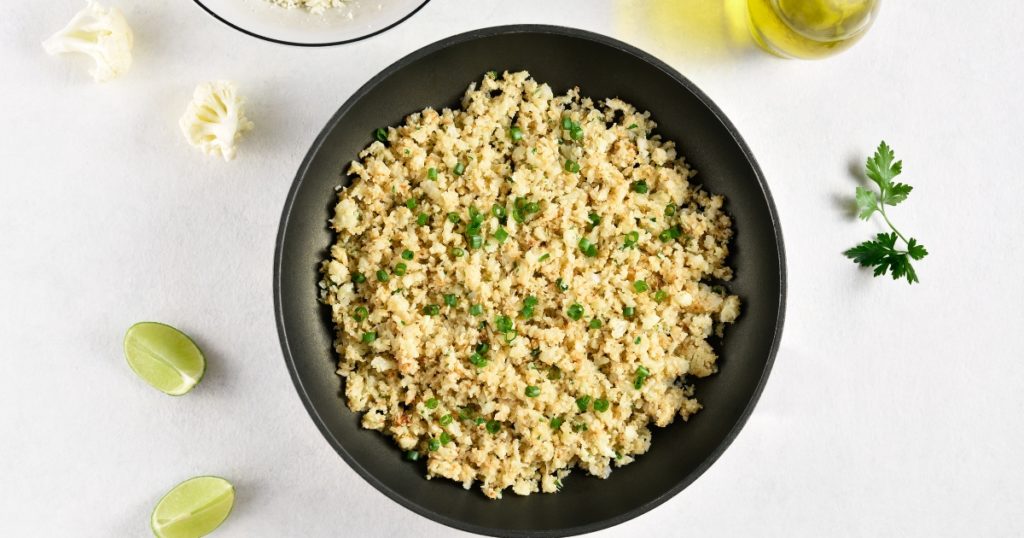
For us Filipinos, rice is life. Hey, we even have various desserts that are basically rice, right? That’s how rice-obsessed we are.
Sadly, rice is not keto-friendly–one cup alone would kick you out of ketosis. But you don’t have to say goodbye to rice, especially if it’s your staple for your meals. Check out some of these keto rice substitutes.
- Broccoli or Cauliflower Rice: Cauliflower and broccoli are both versatile vegetables that can be used in many keto recipes, including as a substitute for rice. Simply chop your chosen vegetable into small pieces and pulse in a food processor until it reaches a rice-like consistency. If you don’t have a food processor, use a grater or chop up the veggie until you get rice-sized pieces. Cook it up in a pan and serve as your keto diet substitute for rice.
- Cabbage Rice: Cabbage is another vegetable option for a rice alternative. It’s low in carbs and easy to prepare. Just shred the cabbage using a knife, a grater, or a chopper. Its slightly sweet flavor goes well with savory food like eggs and meats.
- Shirataki or Konjac Rice: Shirataki and Konjac are both high-fiber, low-carb and very low-calorie rice substitutes. They’re chewy and neutral in flavor, meaning they pair well with any kind of food. You can buy these online; you might see stores selling shirataki noodles, which means you can also have low-carb and low-calorie ramen and other noodle dishes.
It might take some time to get used to these, but we promise: you’ll get to the point of enjoying them.
Keto Substitutes for Bread
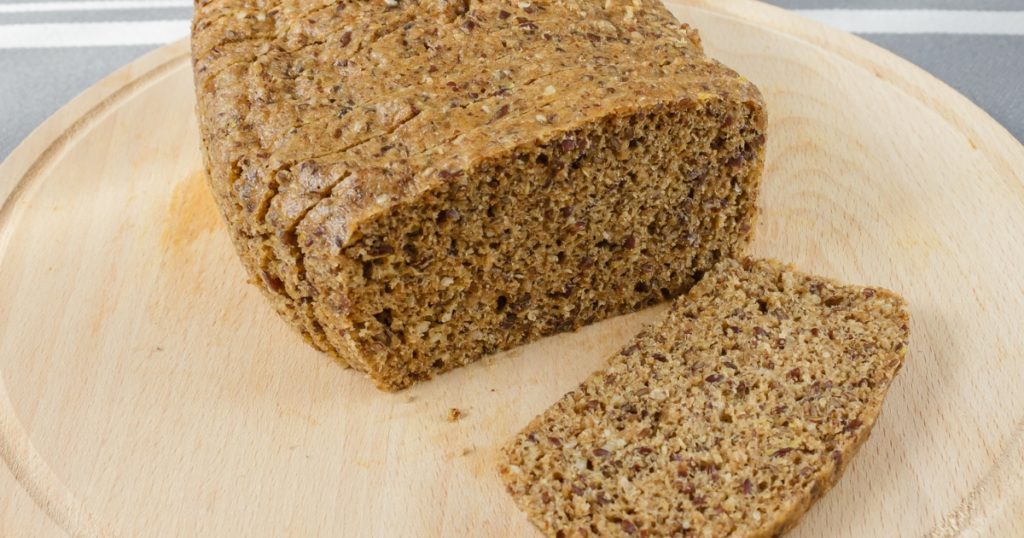
If rice is life for Filipinos, bread comes as a close second. After all, we have plenty of favorites in Pinoy bakeries and various spreads to enhance our enjoyment. Sadly, since the usual white bread has a high carbohydrate content, it’s another food you have to avoid.
Good thing there’s keto bread–as in keto substitutes for flour bread, such as:
- Coconut Flour Bread: Coconut flour is a low-carb alternative to wheat flour and can be used to make keto-friendly bread. You’ll get bread high in fiber and protein and a natural sweet taste.
- Almond Flour Bread: Almond flour is another low-carb flour that can be used to make keto-friendly bread. Your bread will have a slightly nutty flavor and a dense texture.
- Cloud Bread: Cloud bread went viral because of TikTok. But what is cloud bread, exactly? Well, it’s a light and fluffy bread alternative made from eggs, cream cheese, and cream of tartar. It’s another great low-carb option!
And if you’re looking for exact recipes on how to make keto bread, look no further than our class here at The Bailiwick Academy: Keto Bread The Gluten Free Series! You’ll get to make four kinds of keto bread: Keto Dinner Rolls, Keto Loaf Bread, Keto Burger and Hotdog Buns, and Keto Pan de Sal.
You definitely won’t have to say goodbye to bread!
Keto Substitutes for Various Desserts

Just because you have to do keto doesn’t mean dessert is off-limits for you. There are plenty of low-carb alternatives for desserts, such as:
- Keto Ice Cream: No need to look for a keto substitute for ice cream, as there are already plenty of keto ice cream brands in the market. They come in various flavors, and plenty taste like the real thing. You can even make your own–enroll in our Keto Ice Cream class to get started.
- Keto Cakes: If you need to satisfy your sweet tooth, rejoice, as keto cakes are now included in low-carb foods that are on the market. You no longer have to worry about them being high in sugar and carbs since these cakes are made with keto substitutes that are friendly to your diet. For example, they use almond or coconut flour instead of cake makers using wheat flour. And just like with ice cream, you can get started making Keto Cakes here at The Bailiwick Academy. Choose from Keto Cakes, Keto Cheesecakes, or Keto Cakes 2, and come up with plenty of guilt-free delicious cakes!
You can also indulge in donuts, muffins, brownies (available in our Keto Easy-Bake Bestsellers), and even various Filipino favorites like bibingka and puto bumbong.
Do take note that even though these keto desserts are lower in net carbs than their traditional counterparts, these keto alternatives should still be eaten in moderation since they are generally high in calories and fat. Practice enjoying them as occasional treats.
Zero Carb Drinks

If you like drinking Coke, Pepsi, and any other carbonated drinks, you should be aware by now of their high sugar content. But you don’t have to look far for keto alternatives to soda. You don’t have to get rid of soda entirely, either.
Coke Zero, Coke Light, Sprite Zero, and Pepsi Max are all keto-friendly. They’re zero calories too! The same goes for plenty of other drinks in the market, like Rite N’ Lite.
Of course, make sure to check with your personal doctor how much of these you can safely consume in a day.
Keto Substitutes for Snacks

Like eating fries, potato chips, and other salty snacks? We can’t blame you–they’re delicious and can be quite comforting, especially if you’ve had a very long day. The carb count for these, though, is a different story.
You don’t have to stop snacking though–just exchange your usual high-carb foods with low-carb ones. For example, instead of eating chips, eat chicharon or pork rinds instead. They’re also crunchy and salty, but most importantly, they carry a zero carb count.
You can also eat nuts and seeds instead. You’ll have to read the label and/or do research, but plenty of them have low net carbs. Just be sure to limit your intake to follow your daily carb limit.
One more you can do is use zucchini as a potato substitute. Zucchini has lower carbs and calories compared to potatoes, so you can make zucchini chips or zucchini fries instead. When sliced thinly and baked or fried, zucchini can have a crunchy texture that is similar to potato chips or fries.
Don’t know it until you’ve tried it!
Keto-Friendly Sweeteners

Pinoys use sugar in everything, especially for our morning coffee. But as we already know, sugar is not allowed in keto diets. Use the following substitutes instead:
- Stevia: Stevia is a natural sweetener that is derived from the stevia plant. It has no calories, and some describe it as much sweeter than regular sugar. Stevia is the most-talked-about keto substitute for sugar because it doesn’t impact the levels of different people’s blood sugars.
- Erythritol: Erythritol is a sugar alcohol that is commonly used as a sugar substitute in the keto diet. It has only 0.2 calories per gram and also does not have an impact on blood sugar levels. However, according to Healthline, consuming too much of it may cause digestive issues, including nausea.
- Monk Fruit: Monk fruit is a natural sweetener that is derived from the monk fruit plant. It also has no calories and can be much sweeter than the usual sugar. It does not have an impact on blood sugar levels. You’re more likely to find monk fruit in online stores here than in groceries.
- Sucralose: Sucralose is a no-calorie sweetener that is made by modifying regular sugar molecules to create a new compound that the body does not recognize as sugar. While sucralose is generally considered safe to consume in moderation, some believe that consuming artificial sweeteners like sucralose can cause an insulin response. Research on this topic is mixed and has no official conclusion yet.
Will artificial sweeteners stop ketosis? Some people seem to think so, but there’s no evidence suggesting that keto sugar substitutes will affect ketosis. So until there’s actual evidence, keep on using it.
Keto Substitutes for Pasta

Pasta noodles are again, high in carbohydrates. After all, traditional pasta noodles are made from wheat flour which has 76g of carbs for every 100g. However, you can choose from any keto alternative to pasta that can be used to recreate keto-friendly pasta meals, such as:
- Zucchini Noodles (Zoodles) – Zucchini noodles are made by spiralizing zucchini into thin, noodle-like strips. They have a similar texture to pasta, making this one of the most popular keto diet replacements for pasta.
- Spaghetti Squash – Spaghetti squash is a type of winter squash that can be roasted and shredded to create a pasta-like texture.
- Shirataki Noodles – We’ve mentioned these before, but instead of in rice form, they’re now in noodle form. Like zucchini noodles, they have quite a similar texture to pasta.
Final Thoughts
As you can see, just because you’re on a keto diet, it doesn’t mean you have to give up your favorite foods altogether. There are plenty of delicious and satisfying keto-friendly alternatives out there that can help you stay on track while still enjoying the flavors you love. We hope this list gives you a headstart on looking for those keto substitutes.
In the meantime, we wish you all the best as you go on your keto diet. Here’s to a better and healthier you!
Speaking of Keto Pasta…
If you’re interested in making your own keto pasta–and achieving it in the fastest and best time possible, then you’re in luck. The Bailiwick Academy has a new course by Ms. Chiqui Dingong: Keto Pasta!
Check out the video below to learn more about our latest class:
When you enroll in Keto Pasta, you’ll learn to make low-carb and sugar-free pasta dishes that are just as delicious as the real deal. Not only will you learn to make three kinds of pasta (fettuccine, lasagne, and spaghetti), but you’ll also get recipes for three pasta sauces: Truffle Mushroom Cream Sauce, Ragu ala Bolognese, and Pesto ala Genovese.
And guess what? You’ll be making REAL pasta noodles! No substitutes like shirataki–but you’ll have to enroll in this course to find out how Ms. Chiqui does it!
Satisfy that pasta craving with these delectable pasta dishes without the guilt–and appeal to customers who are looking for keto alternatives, too! Sign up at The Bailiwick Academy today to get started!
Oh, and if you’re reading this now (May 15, 2023, Philippine Time), this new course is on sale until 8:30 PM today! Make sure to grab it before the sale expires!
—
Keep coming back to The Bailiwick Academy blog for more kitchen tips, tricks, and much more!
]]>Really, that’s going to be the topic, staying healthy during the holidays? The few moments in a year where you have an excuse to indulge in less-than-healthy food choices? When can you enjoy holiday parties, spend time with friends and loved ones and not think about staying healthy?
Well, this might be a downer of a topic, but you do want to spend MORE holidays with family and friends, right? That means while you don’t have to be super strict about having a healthy lifestyle (enjoy the holidays, seriously), you can take steps to ensure that your holiday health is as good as possible.
After all, you don’t want to be spending time in the hospital or consulting your doctor in family medicine instead of celebrating, right?
So how do you stay as healthy as possible during the holiday season? In no particular order, here are five tips for staying healthy (as healthy as can be, at least) during Christmas and New Year!
How to stay healthy during the holiday season: Wash your hands.

Washing hands is something that is severely underrated in keeping good health. And it’s also something you should do for yourself especially during this holiday season, as the holiday season is also flu season, and we know that washing hands can help prevent you from getting infected.
So if you don’t have your flu shot yet, better safe than sorry!
Oh, and a non-flu reason: your hands go everywhere. So you might not pick up the flu, but you might pick up something else. And if you’re the one who’s assigned to prepare food, you don’t want people getting sick just because you didn’t wash your hands, right?
Make sure to follow proper guidelines in washing hands so that you know what you’re doing is really effective.
How to stay healthy during the holiday season: Drink water and stay hydrated.

Since it’s cooler during this holiday season, you might forget to drink water. Plus, when you’re at a holiday party, there’s likely alcohol, fruit juices, soda and plenty of other more interesting things to drink than plain old water, right?
Well, as much as water is boring, we still need a lot of it to keep our holiday health. After all, not only does water make up 60% of our body’s total weight (which we need to maintain), we also need water for several important bodily functions such as delivering nutrients to the body.
Without enough water, you become dehydrated. And when you become dehydrated, you’ll feel hungry, sluggish, and tired, which can make you miss workouts, eat not-so-good foods, and snack.
So sure, try the delicious drinks that are available, but as Healthline recommends, make sure to drink eight 8-ounce glasses of water a day.
And if you’re indulging in alcohol, alternate each sip with a glass of water. Trust us, you’ll love yourself when you wake up the next day.
How to stay healthy during the holiday season: Get plenty of sleep.

One reason we personally love the holidays is that there’s less activity, and that means more time for sleep! It’s such an underrated activity, but hey, don’t knock it until you’ve tried it.
And when you have enough sleep, you’ll just feel really good!
The problem is that with so many holiday activities that are coming up with family and friends, you might find yourself not getting that at all. That’s especially if you’re the one doing cooking for family dinners, or you’re taking care of last-minute Christmas orders.
But as much as you can, try to stick to a regular bedtime every night, despite all the happenings. When you don’t have sleep, you’ll experience fatigue and you’ll be grumpy and cranky, so you won’t enjoy the holidays.
Plus, when you lack sleep, you can experience the following:
- Short-term problems like lack of alertness, daytime sleepiness, bad memory, and relationship problems.
- Long-term serious health problems like high blood pressure, diabetes, heart attack, lower sex drive, and obesity.
- A less-than-ideal appearance, with you having more wrinkles and dark circles under your eyes.
Make sure to get at least 7 hours of sleep to get its full benefits!
Stay healthy during holidays by not forgetting to do physical activity.

Holidays can be an excuse to lounge around the bed or the sofa all day, but don’t do that! Don’t forget to keep moving and exercise. Not only can it help you shed some unwanted pounds that you will acquire over the holidays, exercise will also help blood flow and circulation, which is always good for your heart and for your health overall.
And don’t worry, you don’t even have to go to the gym or do hardcore jogging. A simple walk around the street will do – what’s important is you get exercise in, no matter how small or how short.
You can also use this as an excuse to have physical bonding activities with your family. If your child likes soccer or basketball, indulge them. You can also do other things like Tag, hide-and-seek, or plenty of other Filipino children’s games – at least, if you can handle the exertion!
One more tip to staying healthy: Remember that you don’t have to eat unhealthily.

Okay, so we made mention that the holidays are usually an excuse to NOT be healthy, right? But if you really want to know how to eat healthy during the holidays, well, here’s what you should know:
You are under no circumstances obligated to overeat during the holidays at all. Sure, your aunt or mom or grandfather will likely urge you on to eat, eat, eat until you’re stuffed, but you can always say no politely, or say you’re full.
And if you really want to stick to healthy food choices during Christmas and New Year, there’s nothing wrong with that either! If you’re hosting, make sure to prepare fruits and vegetables for yourself. And hey, you never know if some of your guests are actually looking for them as well, right?
And if you do want to indulge a bit, remember that portion control is your best friend. Use small plates. Before going over to the less healthy offerings, fill up first with healthier food. That way, you’ll have less space for other food.
Most of all, if you don’t feel hungry, STOP EATING. It’s that simple, really.
Final thoughts: why holidays are good for your health, despite the indulgence

Those are just some tips on how to stay healthy during the holiday season. Take note that these are by no means medical advice from doctors (we’re not a health blog after all), so if you’re really sick or need a physician, please see one immediately.
Going back, we don’t want to cause you any undue holiday stress, so don’t feel any pressure to form any healthy habits or start eating healthy food or even experience weight loss during this time. At the end of the day, a holiday is to be enjoyed, not a reason for you to feel guilty. You can always go back to trying healthy living when the holidays are over, right?
And ultimately, do you know why holidays are good for you, despite you being more likely to eat and drink not-necessarily healthy food and gain weight?
Well, according to the Better Health Channel, spending time with family and friends or simply just a loved one is good for your health and wellbeing, and can even strengthen your immune system. When you don’t have social connections, your physical, emotional, and mental health are all poorer.
Plus, holiday seasons usually mean vacations! That means you can relax and cut down on working (or even overworking), and just generally enjoy the long downtime. Sure, you might experience some weight gain or something, but as long as you generally don’t overeat every single night, that’s fine.
And besides, over the holidays, you’re likely to just gain a pound or two. But still, keep everything in moderation throughout the holiday season, yes?
Speaking of favorite holiday food and how to stay healthy during the festive season…
We know avoiding some of your favorite holiday food is hard, to say the least. After all, we’re Pinoys – we love food, like Christmas ham. And one thing we Pinoys never run out of is Christmas party food ideas.
And one of the things we really love to eat especially during this season (actually, even if there’s no occasion) is kakanin. But these native delicacies are packed full of sugar. Do we really have to avoid these as much as possible or risk seeing our primary care physician, especially if we already have a medical condition?
Well, not necessarily… That is if you’re eating products from our latest class with Ms. Chiqui Ortiz Dingcong: Keto Bibingka Atbp!
That’s right! A guilt-free holiday season is now possible thanks to our resident Keto advocate! You’ll be able to learn recipes for two kinds of bibingka, puto bumbong, and even a bonus recipe for tsokolate de batirol – all free of sugar!
You’ll be able to indulge in these because they won’t fall under the food you shouldn’t eat while on the keto diet!
So what are you waiting for? Sign up at The Bailiwick Academy, learn these healthy recipes, and truly enjoy a favorite holiday of Filipinos!
And we bet that once people find out you’re capable of making sugar-free goodies… Well, let’s just say they might be ordering a lot from you! Talk about a truly happy holiday, wouldn’t you agree?
—
Keep coming back to The Bailiwick Academy blog for more kitchen tips, tricks, and much more!
]]>In fact, your mental health can crumble any minute now, with the looming mom guilt and you thinking that you’re not doing enough to take care of your husband, your children, and your customers.
I can totally relate. As a mother of two who is running The Bailiwick Academy as well as many other pursuits, I know the feeling of being stretched too thin. There are days when I feel like my life as a full-time working mom is like a balancing act where I’m going to end up dropping everything.
There are also times that I asked myself why a work-life balance is so hard to achieve, or why is it so hard to be a working mom. Especially since sometimes, being committed to working and to family seems like an impossible, exhausting, and thankless task.
Well, after many years of doing this, I’ve kind of figured out how to keep myself as a happy working mother – without feeling guilty!
Here are some helpful tips I learned on how to be a happy mom. They’ve worked for me, and I hope my sharing these can help you too – and be life-changing for the better.
Let’s get to it!
First thing to ask yourself: are you taking care of yourself to be happy?

Are moms happy? As in truly, really happy?
Well, that’s a question we moms should really be asking ourselves. Usually, what happens to us is that we end up taking care of everybody except ourselves! You might be a stay-at-home mom, but that doesn’t mean you shouldn’t include yourself in the care, right?
One of your priorities is really how to be a happy mommy, not just making other people in your life happy. Because if you’re not happy, how can you make other people happy? You’re just going to end up resenting the people in your life, as well as your job.
That means you need to dedicate time for your own happiness as well as personal career growth. While it might make you feel bad and guilty, I’m here to tell you right now that there’s nothing wrong with thinking about yourself or putting yourself first.
You don’t even have to wait for Mother’s Day or Valentine’s Day just to get a gift. You can do it for yourself, if that’s how you do self-care.
Again, as I already mentioned, if you can’t care for yourself first, you won’t be able to take care of your family and your customers. So make sure you do this first!
So… how to be happy as a working mom, exactly?
I’m glad you asked! In no particular order, here are a few ways to do self-care, feel better about yourself, and end up being a truly happy working mother.
1. Stop saying yes to everything and you will be happier.
Do you feel guilty about saying “No” to some requests of your children, your spouse, or your customers? Well, don’t! That’s especially if you really don’t have time to do that request anymore, or you’re just too tired.
I’m not saying to say no to important things like, say, date nights with your hubby or quality time with your kids, or overall family time. But if you really can’t bake cookies for your daughter because you’re too tired, or you can’t accommodate an order because your plate is full of orders, just say so.
Your family will understand. And let me tell you, no amount of money is worth any amount of stress! Learn to say “no.”
You’ll be surprised that it will make you feel better after – trust me!

2. Don’t be a working mother all the time. Commit to some “me time” throughout the day.
Every day, you might find yourself taking care of everyone’s concerns except what you want to happen. Well, it’s time to set boundaries!
What I mean is that you should take breaks throughout the day for yourself, to help you recharge. You can turn off your cell phone and enjoy peace and quiet, or actually get on the phone and start watching some Netflix, say your favorite historical Korean drama.
Every day, you might find yourself taking care of everyone’s concerns except what you want to happen. Well, it’s time to set boundaries!
What I mean is that you should take breaks throughout the day for yourself, to help you recharge. You can turn off your cell phone and enjoy peace and quiet, or actually get on the phone and start watching some Netflix, say your favorite historical Korean drama. Think of it as spending quality time with yourself.
Whatever activity you feel like doing, just make sure to take these “me time” moments so that you can recharge and feel much happier. And if you’re wondering how often should a mom get a break, my answer is: as much as you need!

3. Lower your expectations.
One thing that makes you less happy than we are is that we expect too much from ourselves as moms. For example, your children have to be this way, your house has to be super clean, and so on.
Even our bakes or cooking, they have to be the most delicious, or the best-looking.
But if you actually take a step back and look closely, the people you take care of, whether family or customers, aren’t happy because what you’re doing is perfect. What you’re already doing for them is more than enough. After all, they’re not requiring perfection from you!
Also, once you accept that life is not perfect, that takes off the pressure of having to be perfect and you become much happier.
4. Change your environment from time to time.
Yes, you may be one of the many stay-at-home moms, but that doesn’t mean you never get to step outside the home, right? In fact, research suggests that you can refresh your mind by changing your environment. So if you’re feeling trapped or down in your house, step outside of the home.
Do something like I did when I visited Chef Ely Salar’s restaurant in The Podium. That was a fun experience and helped me recharge, ready to work!

5. Take care of your health to be a happy working mother.
One of the best ways for us to be happy is to take care of our health. That means you should prioritize sleep, for one thing. If you get enough sleep, not only will your body function better, you’ll be able to extend more patience and be more relaxed throughout the day.
Another way to take care of our health is to exercise. It doesn’t have to be the gym. You could simply just go walking during your “me times.”
I personally go biking. There are many exercises you can do. The important thing is that you exercise, as it can contribute to your happiness!

And finally, taking care of your health means eating better, like avoiding sugar, eating whole grains, and adding vegetables to your diet. Research suggests after all that eating healthy makes you feel better, not just help you lose weight.
It’s all about finding balance.
The answer to the question of how to be a happy mom and wife while working is to take care of yourself first. Make sure you’re happy before thinking of others. It’s that simple.
And of course, just learn to accept what happens, and to go with the flow a little. Happiness and success may not look exactly like how you pictured it, but just take it one day at a time and learn to relax.
And when you do that, you’ll find yourself much happier, which will make you happy to do stuff for your family and to handle your food business. I can personally testify to it!
Speaking of staying healthy to be a happy working mother…
I know that it’s the Christmas season, so it’s kind of hard to control eating delicious sweets and indulging. After all, it’s only once a year.
And that’s why I’m thankful that Ms. Chiqui Ortiz Dingcong is one of our instructors at TBA. Not only is she bringing various keto recipes for us to learn, she’s also releasing a new class just in time for Christmas: Keto Cakes 2!
Following the success of her Keto Cakes 1 class where she taught recipes for three moist, luscious, and to-die-for keto cakes plus a bonus recipe of keto condensed milk…
When you enroll in Keto Cakes 2, you’ll learn THREE more cakes that are moist AND delicious: a keto version of the classic Tiramisu, keto strawberry shortcake, and a decadent salted caramel cake that you won’t believe is keto!
Gone are the days of dry, crumbly, and tasteless sugar-free, guilt-free cakes! All these are something you’d want to eat over and over again.
Oh and if I didn’t mention it, indulging in something good IS one of the ways how to be a happy working mother. Eat a little bit, or a lot – it’s up to you because again, it’s totally guilt-free.
So what are you waiting for? Sign up at The Bailiwick Academy and get started making keto cakes in time for the holidays!
See you inside!
P.S. Enroll now and get 20% off the original price!

This special offer is good only up to 8:30 PM today, October 31, 2022, so don’t delay and enroll now!
—
Keep coming back to The Bailiwick Academy blog for more kitchen tips, tricks, and much more!
]]>“But Grace, I’m fine! I’m a strong woman! I don’t need to relax! Besides, there are bills to pay. I can’t afford to rest!”
I used to tell myself those same things all the time. But then I got burnt out from all the overworking I did, and started to experience both physical and mental challenges.
It got to the point that I just wanted to collapse on my bed, cover myself with blankets, and just not do anything.
It was THAT BAD.
But of course, I can’t do that. I have a family, responsibilities, a business to run, and so on. And that’s why I started looking for techniques to relax my anxiety.
Here are five that worked for me. For me, they are ways to relax instantly! Try them out and let me know if they worked for you.
Technique to Relax 1: Just take deep breaths.

You may not pay attention to your breathing all that much – after all, it’s something that’s automatic. But did you know that breathing helps you reduce stress?
Wait, why is breathing an essential part of relaxing?
Well, according to the American Institute of Stress, breathing from your abdomen from twenty to thirty minutes each day reduces your anxiety and stress. It will increase the oxygen supply to your brain and stimulates the parasympathetic nervous system, which will help you feel calmer.
Right as Rain further adds that by breathing slower and deeper from your stomach, you actually send a signal to your nervous system to calm down.
In short: deep breathing can lessen stress and anxiety.
Do take note that you don’t have to be into yoga or something related just to be able to do breathing exercises and techniques. Also, it does take practice – it won’t help you immediately.
Take the time to schedule it deliberately throughout your day and make it a habit. I take the time to do this every end of the day and it just works really great for me. But I had to make it part of my routine for it to take effect.
Finally, there are plenty of breathing techniques to relax anxiety – try them all and see which one works best for you.
Technique to Relax 2: Get a massage.

I definitely recommend getting a massage as one of the techniques to relax your body. And not only will your body feel relaxed, but your mind also will too! How does that happen, you ask?
The Mayo Clinic says that getting a massage has plenty of benefits, including:
- The reduction of stress, pain, muscle soreness, and tension
- The improvement of circulation, energy, and alertness
- A lowered heart rate and blood pressure
- An improved immune function
And not only that, but massage can also help fight off anxiety, headaches, insomnia related to stress, and more!
You’ll also get a pleasant emotional response since the massage will relax your body via increased blood circulation and plenty of released endorphins.
I personally get at least one massage a month – and it feels so good! No need to go to a fancy spa. Just schedule a session with your friendly-neighborhood masahista to go to your house.
You’ll be glad you did!
Relaxing Technique 3: Write things down.

Have you ever been told that if you have bad feelings to just write them in a notebook to help you process things?
Well, this technique personally works for me! I write down all my negative feelings. And when I release them on my pad or notebook, I automatically feel much better. A formal term for this exercise is called mood journaling.
I’m not a psychiatrist or an expert in mental health, but basically, when you do this, you get to understand your thoughts and feelings more clearly. It’s a great way for me to control my emotions and improve my mental health – I highly recommend you try it for yourself especially if you’re feeling plenty of negative feelings.
Try not to worry about your grammar or if what you’re writing makes sense or if you’re writing neatly. What’s important is that you’re able to let go of all things bad. Express yourself.
I promise you’ll feel much better.
Relaxing Technique 4: Go out.

For me, one of the best tips to relax and unwind is to just get out of the house, especially if work is done inside the house most of the time. So home bakers, this is the sign you’ve been looking for:
Hang up your apron, put on some outside clothes, and just go wherever you want to go! It can be the mall, like how my daughter and I visited Chef Ely Salar’s shop in The Podium. Or it can be nature, as Healthline suggests.
The point is to just get your mind off of the things that stress you out. You don’t even have to spend money if you don’t want to. Just getting out of a stressful environment will do wonders for your mental health.
And once you come back, you’ll find that you’re actually thinking much clearer than before you went out. So if for example you’re working on one of our classes and are unable to get the technique down, you might have better luck if you go out first.
Don’t knock it until you’ve tried it!
The fifth of the techniques to relax that I especially love: Baking bread.

Now, I know I said that leaving the kitchen will help you relax, but I’ve also found that baking bread can be quite therapeutic in my case. Why?
There are plenty of reasons. For example, the measuring and following recipes that I have to do to make bread are calming. That’s because it’s a routine, and having a routine helps relieve stress.
The routine also helps me feel that I am in control, which is a great way to combat anxiety. After all, we feel anxious the most when we feel like things are out of our control, right?
Also, baking just puts me in a zone where I forget everything that’s not related to what I’m doing right now. I become more mindful if you will.
Finally, looking forward to the delicious output after our hard work is something that is definitely stress-relieving, wouldn’t you agree?
And hey, if psychologists confirm this, who are we to argue, right? Let’s just go bake some bread!
Speaking of techniques to relax and baking bread…
If baking bread is what you need, then enrolling in The Bailiwick Academy is perfect! We have plenty of bread classes for you to try, like Keto Bread, Commercial Breads, Asian Breads, Spanish Bread…
And of course, our latest class offering from Chef Joey Prats: Crusty European-Style Whole Wheat Bread!
In this class, not only will you feel relaxed (because as mentioned above, baking can be therapeutic), but you’ll also learn how to make quality, high-end artisan bread! Chef Joey will share with you his recipe that is fantastic even for beginners: it’s simple, easy to do, doesn’t require any special equipment, and can be used to produce a variety of whole wheat bread variants!
And most importantly, you’ll be able to taste bread that has a moist, chewy interior with a crisp crust. It’s great for sandwiches for your family and even for your food business!
So what are you waiting for? Get some relaxation and artisanal bread. Sign up at The Bailiwick Academy today!
—
Keep coming back to The Bailiwick Academy blog for more kitchen tips, tricks, and much more!
]]>That might be the question in your mind, especially since you (like all of us) are feeling the heat! It’s already May. Is it even summer at this point?
We definitely understand feeling the urge to indulge in something both cool (cold?) and sweet to combat the heat. (Hey, it rhymes!) However, if you are on a keto diet, you might kick yourself out of it with even just a lick!
So, does ice cream count as one of the many keto dessert foods out there? Or is it something that has to be avoided at all costs in a ketogenic diet?
We’ll take a look at that (and more!) in this article. Let’s get to it!
So… Is ice cream keto?
We don’t want to be one of those articles that don’t answer the question immediately, so here it is.
According to Healthline, since ice cream generally has a high carb count, most of which come from sugar, it typically doesn’t fit into a keto diet.
Sorry to bring your hopes up.


Why is ice cream not keto? What’s it made of?
Well, you already know it has sugar. Aside from that, most ice cream brands have milk, cream, and usually, a flavor.
Speaking of flavors, that’s the great thing about ice cream – it’s super flexible! You have standard flavors like vanilla, chocolate, and fruits like mango or banana. Then there are also non-standard ones like chocolate peanut, caramel with sea salt, and mint chip ice cream.
One more great thing about ice cream is that it’s not exclusive to any professional ice cream maker. You can make it at home, and customize it to your tastes. For example, you can use coconut milk and make dairy-free ice cream.
(Speaking of making ice cream, check out our class with Chef Joey Prats: Artisan and No Churn Ice Creams! You’ll be taking homemade ice cream to the next level, guaranteed!)
So… is homemade ice cream keto-friendly?
Well, if you make ice cream with the usual ingredients, then no, your end result will probably not be keto-friendly.
Will ice cream ruin keto? Are you sure?
Remember, to be in ketosis (and to stay there), you need to eat fewer than 50 grams of carbs per day. Carb counts of more than 50 grams will make you leave your ketogenic state.
What does this have to do with ice cream? Well, the usual ice cream brands have the following nutritional values for ½ cup:
Now, if you compute the sum of carbs and sugar, ½ cup will not kick you out of ketosis. But face it, how many of us can stop at just a half-cup? Plus, how many other carbohydrates will we be eating in the day?
Let’s just say that indulging in the usual ice cream is definitely a gateway to leaving ketosis. Unless, of course, you have super self-control.
Darn it! Where did ice cream come from, anyway?
According to BBC, there are plenty of ice cream origin stories such as:
- A kind of ice cream was invented in China back in 200 BC. It was a milk and rice mixture that was frozen by packing it into the snow.
- King Tang of Shang ate an ice cream-like food in China back in 618-97 AD. It involved 94 ice men making a dish of buffalo milk, flour, and camphor.
- Roman emperors were known to have sent slaves to the tops of mountains to bring back fresh snow. The snow was then flavored and also became an early form of ice cream.
- Charles I, the King of England, was rumored to have offered his chef £500 a year. Why? To keep his ice cream recipe a secret from the rest of England!
- People believe Marco Polo to have seen people making ice cream when he went to China. He is credited to have introduced the concept to Italy.
- One final story involves Evanston, an American town. During the 19th century, authorities deemed it illegal to sell ice cream sodas on a Sunday. To get around this decree, some traders replaced the soda with syrup. They then called the dessert an ice cream sundae.
Whatever the origins of ice cream, we’re just glad that it exists! Wouldn’t you agree?

Yes, but going back… So, can I eat ice cream on a ketogenic diet?
Is ice cream allowed on the keto diet?
Going back to what we said earlier, you can, as long as you have self-control. And as long as you don’t go past 50 grams of carbs while indulging in ice cream.
Do take note that most ice creams have a lot of grams of net carbs. Yes, even in a half-cup serving. If you are resolute that this will be your only carb for the day, then great!
If not, better choose your carbs wisely. Ice cream might not satisfy your carb craving, after all.
Well, then, is there such a thing as low-carb ice cream?
Now you’re asking the right questions! And yes, there is such a thing! You can also call it keto ice cream.
Hey, if we can have keto cake, why not keto ice cream, right?
What is keto ice cream?
How is keto ice cream different from regular ice cream? Keto ice cream is still ice cream, but for one thing, it’s sugar-free!
That means instead of sugar, the ice cream maker used one of the following low-calorie, low-carb sweeteners:
- Stevia
- Monk Fruit
- Sugar alcohols like erythritol and/or xylitol
Also, keto ice cream tends to have the usual qualities:
- It’s high in fiber, in the form of soluble corn fiber or chicory root fiber.
- It has less dairy. There is still some form of dairy but most of the usual dairy content is replaced with protein concentrate or ultra-filtered milk.
How many carbs are in keto ice cream?
Yes, keto ice cream still has carbs. However, compared to the usual ice cream, it has lower grams of carbs. And that means eating it will not kick you out of ketosis.
As there are plenty in the market, make sure to check the nutritional values of each keto ice cream brand. That way, you can be sure you haven’t gone over your total carb of fewer than 50 for the day!
Can keto ice cream come in different flavors?
For example, we know banana is not a keto-recommended fruit. So is banana ice cream keto?
Don’t worry – if regular ice cream can come in different flavors, so can keto ice cream! For example, the brand Enlightened Ice Cream has flavors like Peppermint Brownie, Caramel Chocolate Double Dough, and Chocolate Glazed Donut. So you can be sure your keto ice cream will be anything but boring!
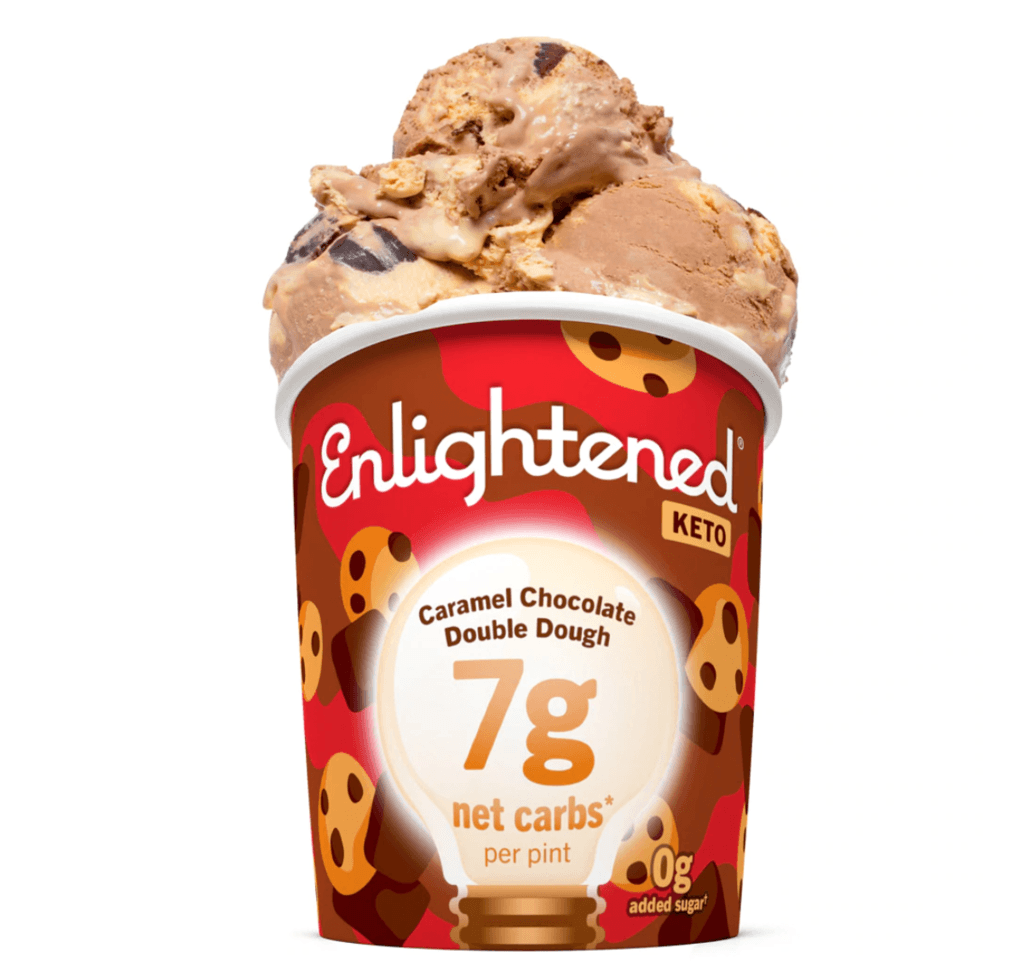
And you can also be sure that the flavoring used will be just fine for your ketogenic diet.
Well then, are ice cream cones keto?
Ice cream is best eaten with an ice cream cone, right? Of course, just because the ice cream you’re eating is keto doesn’t mean your cone is! Don’t worry, there are keto cones in the market – just look for them.
How healthy is keto ice cream?
Is keto ice cream really better than regular ice cream, for instance? Well, we’re not doctors, so we really can’t answer that. The best way to find out is to talk to your doctor or nutritionist.
Oh, and keep this saying in mind: enjoy everything in moderation.
Where is keto ice cream sold?
You can check your local grocery for keto ice cream. They usually have the word keto stamped on them, so you won’t confuse them for regular ice cream. There are also plenty of brands you can buy online.
They seem to be so expensive! Can I make my own keto ice cream?
The answer to this is one big yes! How is keto ice cream made, you ask? Well, The Bailiwick Academy has a class that is great for answering your question.
Introducing: Keto Ice Cream by Ms. Chiqui Dingcong!
Whether you are on a keto diet or you just want to indulge in something sweet without increasing your sugar level, this class is for you! You’ll get to make the following delicious ice cream flavors:
- Avocado
- Chocolate
- Strawberry
Of course, you might have done your research and you might have found complaints about keto ice cream, like, “Why is keto ice cream chalky?” or, “Why is keto ice cream so hard?”
Or you might also have read about this particular ice cream giving bad reactions to people who eat it.
Well, believe it or not, Ms. Chiqui had the same questions, as you can see in this video. That’s why she decided to do something about it!
See? When you enroll in this class, you’ll be creating easy-to-make and delicious keto ice cream.
You don’t have to be intimidated by unfamiliar ingredients or terms. Ms. Chiqui will guide you through the process. And because The Bailiwick Academy lets you replay the video as much as you want, we’re sure you’ll be on your way to making this ice cream successfully!
Scream for (keto) ice cream today! Enroll in The Bailiwick Academy!
P.S. If you’re reading this blog post today, May 15, 2022, then this class is on sale! Act now to get it at 20% off!
]]>You might be wondering about that very important question if one, you’ve been told to start keto by your doctor or your nutritionist, and two, you love eating sweet, sugary cakes.
Sorry to burst your bubble, but the usual cake batter for any cake flavor is not keto.
But here’s good news for you: if there are keto dessert foods, if there are different kinds of keto bread and keto meals, then there’s definitely such a thing as keto cake! And thanks to a lot of keto-friendly ingredients on the market these days, you’ll get plenty of flavors and cake recipes that you can be sure you’ll enjoy on your keto diet.
Let’s take a closer look at keto cakes, shall we?
What is a keto cake?
A keto cake is pretty much a cake. The difference between a keto cake with other cakes is that you don’t use traditional ingredients like flour. What is keto cake made of, you ask? Well, as mentioned above, keto-friendly ingredients such as almond flour, coconut flour, unsweetened chocolate chips, cocoa powder, coconut milk, heavy cream and so much more.
Most importantly, what makes it keto is that its net carb is low compared to the usual cakes. Carbs are practically zero in any keto meal, and keto cakes are not exempted from that fact.
Does it have sugar?

The answer is no. Brown or white sugar is not used on keto cakes. Nor do you use sweeteners like honey or maple syrup. Instead, the cake is sweetened with a sugar substitute like powdered sweeteners (Equal Gold or Stevia), or monk fruit. They’re sweet, but they’re sugar-free!
What cakes are keto friendly?
Any cake can be keto-friendly, as long as its ingredients are legit keto-friendly ingredients. It doesn’t matter what flavor it is (i.e. cheesecake, avocado) or how many cake layers it has! Remember, there are ingredients that can never be keto-friendly, like bananas. So before you eat any supposed keto cake, remember to research! You can also ask your nutritionist or doctors for a complete list of ingredients that fit your new diet.
Does it taste good?

If you’ve ever tasted anything keto before, we’d be willing to bet that you weren’t happy with it. For example, one bite might have left you wondering why do keto desserts taste so bad? Or why is my keto cake grainy? Or even just why don’t they taste good? If you check out this Reddit thread, you’d find others like you who are wondering the same thing and are looking for keto desserts that actually taste good.
Well, according to Keto.Global, most keto desserts don’t taste good because of the lack of ingredients, like sugar and flour. This particular lack, plus a change of ingredients (because you’re using keto substitutes, right?) may cause desserts to have a distinct flavor, texture, and look that aren’t necessarily appetizing. And some ingredients also have a more chemical taste or a bad aftertaste.
To fix this, what you do is basically to find the right balance of substitute and ingredients. It’s that simple. You might have to do a lot of experimenting but you’ll eventually find the right balance. Or you’ll have to try out a lot of keto stores. Once you find the store or bakery with the desserts you like, just keep buying there. Problem solved!
Is keto cake healthy?
If you’re a cake fanatic, you might be wondering, “How much keto cake can I eat?” Is there an amount where you can be considered to have eaten too much keto cake?
Well, like we mentioned in previous blog posts about keto food, we’re not doctors or nutritionists. And the keto diet definitely has some unpleasant side effects. But we do know that because of the little to no sugar content of keto cakes, it’s definitely helpful for controlling your blood sugar content while still tasting something sweet.
And as for the amount of cake you can eat, the only thing we have to say about it is that too much of a good thing can be bad. Remember, you’re going on a keto diet to help you lose weight. But if you still eat too much food, you may be preventing your own weight or fat loss.
In short, we recommend you keep eating keto cakes as a treat. And again, consult your doctor or nutritionist!
Can you make a keto cake?
Now you might be wondering if you can just make your own cake instead of having to Google “is there a keto bakery near me.”
Well, the answer to that is yes, you can – with The Bailiwick Academy!
We’ve just recently released new classes by Ms. Chiqui Ortiz Dingcong, and they’re all about making keto cakes!
Keto carrot cake
Carrot cake is one of those classics with plenty of different cake recipes. With Ms. Chiqui’s keto carrot cake class, you can enjoy the classic and stay on your diet! It’s low-carb, sugar-free, and has moist crumbs and delicious cream cheese frosting.
Keto red velvet cake
Here’s another favorite (and low carb) cake with cream cheese! And rest assured that with the recipe you’re going to learn, you’ll produce a moist, fluffy keto red velvet cake with the perfect balance of sweet and tangy!
Keto chocolate cake
Who doesn’t love chocolate cake? Whether you’re having a slice as a snack or you’re getting a whole one as your birthday cake, chocolate cake is always welcome. And when you enroll in the keto chocolate cake class, you’ll be able to produce one that’s moist, fudgy, luscious, and stick-to-your-teeth delicious! And yes, it’s low carb and free of regular like the two cakes.
With these recipes, we promise you won’t be Googling “why do keto desserts taste so bad” – guaranteed!
But why not learn all recipes for these low carb cakes?
Each class mentioned above costs Php1295. So if you multiply that by three, you get a total of Php3885.
But because The Bailiwick Academy is behind you in turning your passion into profit, we packaged each keto cake recipe in one class! Check out our Keto Cakes class!
That’s right: Learn not one, not two, but all three guilt-free keto recipes by Ms. Chiqui. Not only will you say goodbye to the days of dry and tasteless sugar-free cakes, but you’ll also be able to cater to a brand new market of people looking for keto desserts, like these people in Singapore!
And we can tell you right now, you’ll be able to sell these cakes at premium prices.
Speaking of prices, you won’t get this class at Php3885. Instead, you’ll get it at a very discounted rate of only Php2995, AND you’ll also get a bonus recipe for Keto Condensed Milk! What a deal!
If you’re starting keto for the first time ever or just discovering keto, what better way to start than by learning and indulging in these keto cake recipes, right? You’ll be off to one sweet (but sugar-free!), delicious beginning!
What are you waiting for? Enroll in The Bailiwick Academy today!
]]>
 다들 즐거운 주말 보내요ฅ^•ﻌ•^ฅ
다들 즐거운 주말 보내요ฅ^•ﻌ•^ฅ  스테파니킴치 –
스테파니킴치 – 